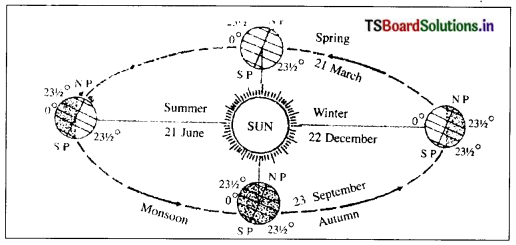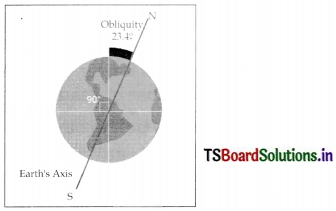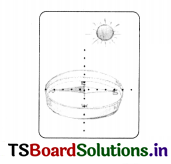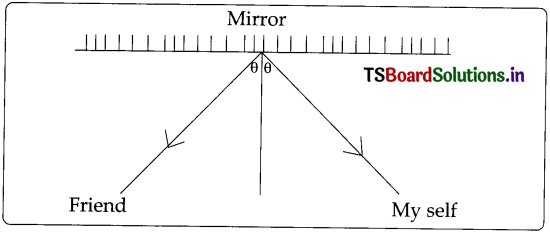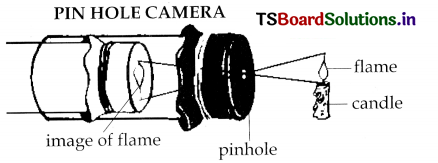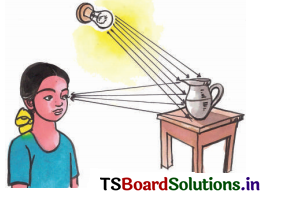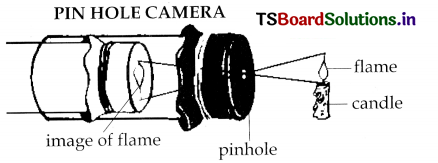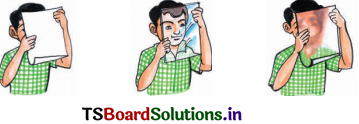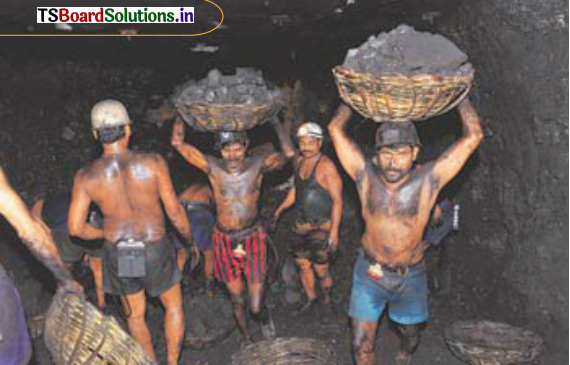Telangana TSBIE TS Inter 1st Year Economics Study Material 9th Lesson ద్రవ్యం, బాంకింగ్, ద్రవ్యోల్బణం Textbook Questions and Answers.
TS Inter 1st Year Economics Study Material 9th Lesson ద్రవ్యం, బాంకింగ్, ద్రవ్యోల్బణం
వ్యాసరూప సమాధాన ప్రశ్నలు:
ప్రశ్న 1.
ద్రవ్య పరిణామక్రమాన్ని చర్చించండి. ద్రవ్య రకాలను వివరించండి.
జవాబు.
ద్రవ్యం అంటే ఏమిటి అనే శ్న సామాన్యంగా కనిపించినప్పటికీ, జవాబు క్లిష్టమైంది. మానవుల కార్యకలా పాలన్నింటికీ ద్రవ్యం కేంద్ర బిందువు. సమాజంలో ప్రజలు పలు రకాలైన లావాదేవీల కోసం ద్రవ్యాన్ని ఉపయోగిస్తారు. ప్రభుత్వం కూడా దైనందిన వ్యవహారాల కొరకు ద్రవ్యాన్ని ఉపయోగిస్తుంది. నేడు ద్రవ్యం యొక్క పాత్ర లేని సమాజాన్ని మనం ఊహించలేం.
అందుకే, వాకర్ (Walker) పేర్కొన్నట్లు “money is what money does” అంటే ద్రవ్యం ఏ పనులను నిర్వహిస్తుందో ఆయా పనుల ఆధారంగా ద్రవ్య స్వభావాన్ని నిర్వచించవచ్చు. మొత్తం మీద మానవుని నవ్య కల్పన (ఆవిష్కరణ, discovery) అన్నింటిలో ‘ద్రవ్యం’ అత్యద్భుతమైందని చెప్పవచ్చు.
ద్రవ్య పరిణామక్రమం :
‘ద్రవ్యం అనే పదం ‘మానెటా’ అనే పదం నుంచి వచ్చింది. రోమన్ దేవత ‘మానెటా” ఆలయంలో నాణేలు ముద్రించేవారు. ఆర్థిక వ్యవస్థలో ద్రవ్యం వాడుకలోకి రాకముందు ‘వస్తు మార్పిడి విధానం’ అమలులో ఉండేది. ఈ విధానంలో వ్యక్తులు వస్తువులకు బదులుగా వస్తువులను వినిమయంగా పొందేవారు.
వస్తు మార్పిడి పద్ధతిలోని ఇబ్బందులను తొలగించడానికే ద్రవ్యం కనుగొనబడింది. ప్రాథమిక దశలో ద్రవ్యం స్థానంలో జంతువులను ఉపయోగించారు.
కాలక్రమంలో బంగారం, వెండి, రాగి, నికెల్ వంటివి లోహ ద్రవ్యంగా చలామణిలోకి వచ్చాయి. మూడవ దశలో నాణేలు ద్రవ్యంగా ఉపయోగించబడగా, ఆ తదుపరి కరెన్సీ నోట్లు ద్రవ్యంగా చలామణిలోకి వచ్చాయి. ప్రస్తుతం, కరెన్సీ నోట్లతో బాటు, వాణిజ్య బాంకులు సృష్టించే డ్రాఫ్ట్లు, చెక్కులు, డెబిట్ కార్డులు కూడా ద్రవ్యంగా చలామణి కావడం మనం చూస్తున్నాం. ఈ విధంగా ద్రవ్య పరిణామక్రమం ఆర్థిక వ్యవస్థలో పలు దశలలో చోటు చేసుకొన్నదని చెప్పవచ్చు.
ద్రవ్యం నిర్వచనాలు :
వస్తు మార్పిడి విధానంలోని ఇబ్బందులను తొలగించడానికి ద్రవ్యాన్ని చలామణిలోకి తీసుకురావడం జరిగింది. అర్థశాస్త్రవేత్తలు ద్రవ్యాన్ని అనేక విధాలుగా నిర్వచించడం జరిగింది.
- రాబర్ట్సన్ అభిప్రాయంలో ద్రవ్యం “వస్తు క్రయ విక్రయ చెల్లింపులలో, ఇతర వ్యవహారాల పరిష్కారాలలో అధికంగా జనామోదం పొందింది.”
- ‘దేనికైతే సర్వజనాంగీకారం కలిగి ఉన్నదో అదే ద్రవ్యం’ అని సెలిగ్మన్ పేర్కొన్నాడు.
- సాధారణంగా ‘వినిమయ సాధనం’గా అందరూ అంగీకరించేది. అంతేకాకుండా విలువల కొలమానంగా, విలువ నిధిగా ఉపయోగపడేది’ ద్రవ్యం అని డా॥ క్రౌథర్ నిర్వచించాడు.
- ‘ద్రవ్యం ఏ పనులను నిర్వహిస్తుందో దానినే ద్రవ్యం’ అని వాకర్ పేర్కొన్నాడు.
ద్రవ్యాన్ని సాధారణంగా ఒక ‘యూనిట్’ రూపంలో వ్యక్తపరచడం జరుగుతుంది. కేంద్ర బాంకు జారీ చేసే కరెన్సీ పేపర్ నోట్లు, చిల్లర నాణేల రూపంలో ఉంటుంది. ఉదా॥ భారతదేశంలో రూపాయి, అమెరికాలో డాలర్, యు.కె. లో పౌండ్ స్టెర్లింగ్, జపాన్లో యెన్, యూరోపియన్ దేశాలలో యూరో.

ప్రశ్న 2.
ద్రవ్యాన్ని నిర్వచించండి. ద్రవ్యం విధులను వివరించండి.
జవాబు.
వస్తు మార్పిడి విధానంలోని ఇబ్బందులను తొలగించడానికి ద్రవ్యాన్ని చలామణిలోకి తీసుకురావడం జరిగింది. అర్థశాస్త్రవేత్తలు ద్రవ్యాన్ని అనేక విధాలుగా నిర్వచించడం జరిగింది.
- రాబర్ట్సన్ అభిప్రాయంలో ద్రవ్యం “వస్తు క్రయ విక్రయ చెల్లింపులలో, ఇతర వ్యవహారాల పరిష్కారాలలో అధికంగా జనామోదం పొందింది.”
- ‘దేనికైతే సర్వజనాంగీకారం కలిగి ఉన్నదో అదే ద్రవ్యం’ అని సెలిగ్మన్ పేర్కొన్నాడు.
- సాధారణంగా ‘వినిమయ సాధనం’గా అందరూ అంగీకరించేది, అంతేకాకుండా విలువల కొలమానంగా, విలువ నిధిగా ఉపయోగపడేది’ ద్రవ్యం అని డా॥ క్రౌథర్ నిర్వచించాడు.
- ‘ద్రవ్యం ఏ పనులను నిర్వహిస్తుందో దానినే ద్రవ్యం’ అని వాకర్ పేర్కొన్నాడు.
ద్రవ్యాన్ని సాధారణంగా ఒక ‘యూనిట్’ రూపంలో వ్యక్తపరచడం జరుగుతుంది. కేంద్ర బాంకు జారీ చేసే కరెన్సీ పేపర్ నోట్లు, చిల్లర నాణేల రూపంలో ఉంటుంది. ఉదా॥ భారతదేశంలో రూపాయి, అమెరికాలో డాలర్, యు.కె. లో పౌండ్ స్టెర్లింగ్, జపాన్లో యెన్, యూరోపియన్ దేశాలలో యూరో.
ద్రవ్యం విధులు :
ద్రవ్యం నిర్వహించే విధులు చాలా ఉన్నాయి. వీటికి ప్రాథమిక విధులు, ద్వితీయ శ్రేణి విధులు, అనుషంగిక విధులు అని పలు రకాలుగా వర్గీకరిస్తారు.
ప్రాథమిక విధులు :
1. వినిమయ మాధ్యమం :
ద్రవ్యం వినిమయ మాధ్యమంగా వ్యవహరిస్తుంది. ఏ వస్తువైనా ముందుగా ద్రవ్యంతో మార్పిడి చేసుకొని, ఆ తరువాత ఆ ద్రవ్యంలో మరి ఏ ఇతర వస్తువునైనా కొనుగోలు చేయవచ్చు. ఆ విధంగా ద్రవ్యం అనే వినిమయ మాధ్యమం ద్వారా ప్రజలు వస్తు సేవలను వినిమయం చేసుకోవచ్చు.
2. విలువల కొలమానం :
వస్తు సేవల విలువ కొలమానంగా ద్రవ్యం వ్యవహరిస్తుంది. వ్యాపార వ్యవహారాలను సులువైనవిగా, సులభతరమైనవిగా మార్చింది. ప్రతి వస్తువు విలువను ద్రవ్య యూనిట్లో వ్యక్తపరచడం జరుగుతుంది. దీనిని ధర అంటారు. ద్రవ్యం యూనిట్ విలువ స్థిరంగా ఉన్నప్పుడు మాత్రమే అది సంతృప్తికరమైన కొలమానంగా పనిచేస్తుంది.
ద్వితీయ శ్రేణి విధులు :
1. విలువ నిధి :
వస్తు సేవల విలువను ద్రవ్య రూపంలో నిల్వ చేయవచ్చు. కీన్స్ అభిప్రాయంలో, ద్రవ్యం నిర్వహించే విధులలో ఈ విధి అతి ముఖ్యమైనది. ద్రవ్యం వల్ల మాత్రమే, ప్రస్తుత ఆదాయంతో భవిష్యత్తులో వినియోగం సాధ్యపడుతుంది. అందువల్ల ద్రవ్యం భూత, వర్తమాన, భవిష్యత్తు కాలాల మధ్య వారధిగా పనిచేస్తుంది.
2. వాయిదాల చెల్లింపుల ప్రామాణికం :
ద్రవ్యం వాయిదా చెల్లింపుల ప్రమాణాలుగా వ్యవహరిస్తుంది. ఈ విధిని నిర్వర్తించడం వల్ల వ్యక్తులు వస్తువులను కొనుగోలు చేయడం, బ్యాంకులు, ఇతర ద్రవ్య సంస్థల నుంచి ఋణాలు పొందడం, షేర్లు, బాండ్లు అమ్మకాలు, కొనుగోలు మొ||నవి సులభతరమయ్యాయి.
3. విలువల బదిలీ :
ఏ సమయంలోనైనా, ఏ ప్రదేశంలోనైనా ద్రవ్యాన్ని ఒక వ్యక్తి నుంచి మరొక వ్యక్తికి బదిలీ చేయడం సాధ్యం అవుతుంది. ద్రవ్యం వల్ల విలువను బదిలీ చేయడం తేలికవుతుంది.
అనుషంగిక విధులు :
1. జాతీయాదాయ మదింపు, పంపిణీ :
ఒక సం॥ కాలంలో ఒక దేశంలో ఉత్పత్తి చేయబడిన వస్తు సేవల విలువలను అంచనా వేయవచ్చు. వివిధ ఉత్పత్తి కారకాలను ద్రవ్య రూపంలో చెల్లింపులు చేయడం ద్వారా జాతీయాదా యమును వాటి మధ్య పంపిణీ చేయవచ్చు.
2. ఉపాంత ప్రయోజనాలు/ఉత్పాదకతలు సమానీకరణ :
వినియోగదారులు తాము కొనుగోలు చేసే వివిధ వస్తువుల నుంచి పొందే ఉపాంత ప్రయోజనాలను ద్రవ్యం ఆధారంగా సమానం చేయడం ద్వారా ప్రయోజనాలను గరిష్ఠం చేసుకోగలుగుతాడు.
అదే విధంగా ఉత్పత్తిదారు వివిధ ఉత్పత్తి కారకాల ఉపాంత ఉత్పాదకతలను ద్రవ్యం సహాయంతో సమానం చేయడం ద్వారా లాభాలను గరిష్ఠం చేసుకోగలుగుతాడు.
3. పరపతి వ్యవస్థకు మూలం :
అన్ని ఆర్థిక లావాదేవీలకు ద్రవ్యం ప్రాతిపదిక. ద్రవ్య రిజర్వు లేనిదే పరపతి సృష్టి జరగదు. పరపతి కార్యకలాపాలన్నింటికి ద్రవ్యం పూచీకత్తుగా వ్యవహరిస్తుంది.
4. ద్రవ్యత్వం :
ద్రవ్యానికి అత్యధిక ద్రవ్యత్వం ఉంటుంది. ద్రవ్యత్వపరంగా ఆస్తులన్నింటిలోకి ఉత్తమమైనది. ద్రవ్యం నూరుశాతం ద్రవ్యత్వం కలిగి ఉంటుంది.

ప్రశ్న 3.
వాణిజ్య బాంకుల విధులను విశదీకరించండి.
జవాబు.
వాణిజ్య బ్యాంకులు దేశ బాంకింగ్ రంగంలో ప్రముఖ స్థానాన్ని ఆక్రమించాయి. వాణిజ్య బ్యాంకులు ప్రజల నుంచి, సంస్థల నుంచి డిపాజిట్లను స్వీకరించి, ఆ సొమ్మును వ్యాపారస్తులకు, ఉత్పత్తిదారులకు ఋణాలను ఇస్తూ, అటు ఋణ గ్రహీతలకు, ఋణదాతలకు మధ్య అనుసంధాన కర్తగా వ్యవహరిస్తుంది.
సేయర్స్ అభిప్రాయంలో “బాంకులు వ్యక్తుల నుంచి డిపాజిట్లను స్వీకరించి, అవసరమైన వాళ్ళకు ఋణాలు మంజూరు చేసే సంస్థలు”.
క్రౌథర్ అభిప్రాయంలో “ఇతరుల ఋణాలు తీసుకొని, తన వద్దగల ద్రవ్యాన్ని ఇతరులకు ఇవ్వడం ద్వారా ద్రవ్యాన్ని సృష్టించడమే బ్యాంకుల వ్యాపారం”.
వాణిజ్య బ్యాంకుల విధులు :
ఇవి దేశ ఆర్థికాభివృద్ధిలో ప్రముఖ స్థానాన్ని ఆక్రమించుకున్నాయి. వాణిజ్య బ్యాంకుల విధులు ముఖ్యంగా
- ప్రాథమిక విధులు.
- అనుషంగిక విధులు.
- సాధారణోపయోగ సేవలు.
1. ప్రాథమిక విధులు :
ఎ) డిపాజిట్లను స్వీకరించడం:
ప్రజల వద్ద నుంచి పొదుపులను డిపాజిట్లగా స్వీకరించడం బ్యాంకుల ప్రాథమిక నంగా వాణిజ్య బ్యాంకులు స్వీకరించే డిపాజిట్లు రెండు రకాలు, అవి : డిమాండ్ డిపాజిట్లు, కాలపరిమితి
- డిమాండ్ డిపాజిట్ల కింద సేవింగ్స్ డిపాజిట్లను, కరెంట్ డిపాజిట్లను సేకరిస్తుంది.
- కాలపరిమితి డిపాజిట్ల కింద ఫిక్స్డ్ డిపాజిట్లను, రికరింగ్ డిపాజిట్లను సేకరిస్తుంది.
బి) ఋణాలను మంజూరు చేయడం :
- లాభాలను ఆర్జించటం వాణిజ్య బాంకుల ముఖ్యోద్దేశం. బాంకులు వ్యాపారస్తుల ద్రవ్య అవసరాల కోసం ఇచ్చే రుణాలను ‘నగదు పరపతి’ అంటారు. ఋణాన్ని తీసుకొన్న ఖాతాదారు, ఆ ద్రవ్యాన్ని ‘చెక్కు’ ద్వారా తీసుకుంటాడు. ఈ ఋణాలపై బాంకులు వడ్డీ వసూలు చేస్తాయి.
- నమ్మకమైన ఖాతాదారులకు బాంకులు “ఓవర్ డ్రాఫ్ట్” పద్ధతి ద్వారా ఋణాలిస్తాయి. ఖాతాదారుని కరెంట్ ఖాతాలో నిలువ ఉన్న మొత్తం కంటే, అధిక మొత్తాన్ని వాడుకొనే వసతిని ‘ఓవర్ డ్రాఫ్ట్’ అంటారు. వాడుకున్న సొమ్ముపై ఖాతాదారుని నుంచి వడ్డీని వసూలు చేస్తాయి.
- కేంద్ర బాంకు ఉత్తర్వుల మేరకు, స్టాక్ ఎక్స్ఛేంజ్ బ్రోకర్లకు వాణిజ్య బాంకులు అతి స్వల్పకాలిక ఋణాలు ఇస్తుంది. వీటిని ‘కాలనీ లేదా కాల్ లోన్స్’ అంటారు. వీటి కాల పరిమితి 15 రోజులకు మించదు.
- ఖాతాదారుల వద్ద ఉన్న బిల్లులపై కాలపరిమితికి ముందుగానే వడ్డీ మినహాయించుకొని మిగిలిన మొత్తాన్ని చెల్లించే అవకాశం కల్పిస్తుంది. ఈ పద్ధతిని “బిల్లుల డిస్కౌంటింగ్” అంటారు.
సి) పరపతిని సృష్టించడం :
బాంకులు స్వీకరించే డిపాజిట్లే అవి ఇచ్చే ఋణాలకు ఆధారం. పరపతి సృష్టి అంటే బాంకు డిపాజిట్ల కంటే ఎన్నో రెట్లు రుణాలు పెంచడం. పరపతి ఇచ్చేటప్పుడు డిపాజిట్లు సృష్టించబడతాయి.
డి) క్రెడిట్ కార్డులు :
ఆధునిక బాంకులు ఖాతాదారులకు ‘క్రెడిట్ కార్డులు’ మంజూరు చేయడం ద్వారా క ఋణాలను మంజూరు చేస్తున్నాయి. క్రెడిట్ కార్డు ఉన్న ఖాతాదారు వస్తు సేవలను కార్డ్పై కొనుగోలు చేసి, బాంకుకు అసలుతోపాటు వడ్డీ చెల్లించడం జరుగుతుంది.
2. అనుషంగిక విధులు :
బాంకులు నిర్వహించే ప్రాథమిక విధుల ఫలితంగా ‘ప్రాతినిథ్య విధులు’ ఏర్పడతాయి.
- బాంకులు ఖాతాదారుల ప్రతినిధులుగా వారి తరపున బీమా ప్రీమియమ్లు, కరెంట్ బిల్లులు మొదలైన వాటిని ఖాతాదారుల ఆదేశానుసారం నిర్ణీత సమయాల్లో చెల్లించుట.
- బాంకులు ఖాతాదారులు ‘ఏజెంట్గా’ కంపెనీల షేర్లను, రుణ పత్రాలను కొనిపెడతాయి.
- ఖాతాదారుల తరపున డ్రాఫ్టు ద్వారా, ద్వారా, తంతి తపాలా ద్వారా సొమ్ము బదిలీ చేస్తుంది.
3. సాధారణోపయోగ సేవలు :
- విదేశీ వ్యాపార క్రమంలో అత్యవసరమైన ‘పరపతి పత్రాలను’ జారీ చేస్తాయి.
- విదేశీ వర్తకం చేసేవారికి ‘విదేశీ ద్రవ్యం’లో విత్త సహాయం చేస్తుంది.
- విద్యార్థులు ఉన్నత విద్యను అభ్యసించటానికి ‘విద్యా రుణ’ సౌకర్యాన్ని కల్పిస్తుంది.
- బాంకింగ్ సేవలలో మరో విప్లవాత్మక సౌకర్యం ATM పద్ధతి ఖాతాదారులు తమకు సొమ్ము కావలసినప్పుడు బాంకుకు వెళ్ళకుండా, తమకు దగ్గరలో ఉన్న ATM నుంచి నగదు తీసుకొనే సౌకర్యం కల్పించింది.

ప్రశ్న 4.
భారతీయ రిజర్వు బ్యాంకు విధులు ఏమిటి ?
జవాబు.
రిజర్వు బ్యాంకు ఆఫ్ ఇండియా మన దేశానికి కేంద్ర బ్యాంకు. దేశంలోని ద్రవ్య, కోశ విధానాలను రూపొందించడం లోను, అమలు పరచడంలో ముఖ్యపాత్ర వహిస్తుంది. ఇది దేశంలోని బ్యాంకింగ్ వ్యవస్థ అభివృద్ధికి నాయకత్వం వహిస్తూ దేశ అవసరాలకు తగినట్లుగా బ్యాంకింగ్ కార్యకలాపాలను క్రమబద్ధీకరిస్తుంది.
రాయల్ కమీషన్ ఆఫ్ ఇండియన్ కరెన్సీ అండ్ ఫైనాన్స్ సూచన మేరకు 1935 ఏప్రిల్లో కౌ 5 కోట్ల వాటా మూలధనంతో రిజర్వు బ్యాంకు నెలకొల్పబడినది. మొదట ఇది ప్రైవేటు వాటాదారు యాజమాన్యం క్రింద ఏర్పడింది. దీనిని 1949లో భారత ప్రభుత్వం జాతీయం చేసింది. 1934 భారతీయ రిజర్వు బ్యాంకు చట్టం ప్రకారం అన్ని ముఖ్యమైన కేంద్ర బ్యాంకు విధులను ఇది నిర్వహిస్తుంది.
దీని ప్రధాన కార్యాలయం ముంబాయిలో ఉంది. ఢిల్లీ, కోలకత్తా, చెన్నై, ముంబాయి మొదలైన నగరాలలో ప్రాంతీయ కార్యాలయాలు పనిచేస్తాయి. 20 మంది డైరెక్టర్లతో కూడిన కేంద్ర డైరెక్టర్ల బోర్డు నియంత్రణ క్రింద ఇది పనిచేస్తుంది.
ఇందులో ఒక గవర్నరు, నలుగురికి మించకుండా డిప్యూటీ గవర్నర్లు, రిజర్వు బ్యాంకు నాలుగు స్థానిక డైరెక్టర్ల బోర్డుల నుంచి ఒక్కొక్కరు కేంద్ర ప్రభుత్వంచే నియమించబడే పదిమంది డైరెక్టర్లు, ఒక ప్రభుత్వ అధికారి, మొత్తం 20 మంది ఉంటారు. వీరందరినీ కేంద్ర ప్రభుత్వం నియమిస్తుంది.
భారతీయ రిజర్వు బ్యాంకు విధులు :
1. కరెన్సీ నోట్ల జారీ :
మనదేశంలోని కరెన్సీ నోట్ల జారీపై గుత్తాధిపత్య అధికారం రిజర్వు బ్యాంకు కలిగి ఉంది. రిజర్వు బ్యాంకు 2,000, 500, 200, 100, 50, 20, 10 ల కరెన్సీ నోట్లను జారీ చేస్తుంది. ఈ నోట్లపై భారతీయ రిజర్వు బ్యాంకు గవర్నర్ సంతకం ముద్రించబడతాయి.
2. ప్రభుత్వ బ్యాంకరు :
రిజర్వు బ్యాంకు కేంద్ర ప్రభుత్వానికీ, రాష్ట్ర ప్రభుత్వానికి బ్యాంకరుగా, ప్రతినిధిగా, ఆర్థిక సలహాదారుగా వ్యవహరిస్తుంది. ప్రభుత్వ బ్యాంకరుగా వివిధ ప్రభుత్వ విభాగాల అకౌంట్లను నిర్వహిస్తుంది.
ప్రభుత్వం తరుపున ద్రవ్యాన్ని స్వీకరిస్తుంది, చెల్లింపులు చేస్తుంది. ప్రభుత్వాలకు తాత్కాలిక ఋణాలు అందిస్తుంది. అన్ని ఆర్థిక వ్యవహారాలలో ప్రభుత్వాలకు సలహాదారుగా కూడా పనిచేస్తుంది.
3. బ్యాంకుల బ్యాంకరు :
దేశంలోని బ్యాంకులకు రిజర్వు బ్యాంకు బ్యాంకరుగా పనిచేస్తుంది. కొన్ని రకాల బిల్లులను రీడిస్కౌంట్ చేసుకునే సదుపాయం వాణిజ్య బ్యాంకులకు కలుగజేస్తుంది. వివిధ బ్యాంకుల మధ్య బ్యాంకింగ్ లావాదేవీలను పరిష్కరించడానికి క్లియరింగ్ హౌస్గా పనిచేస్తుంది. అలాగే బ్యాంకుల కార్యకలాపాలు తీర్చిదిద్ది వాటికి ” నాయకత్వం వహిస్తుంది.
4. అంతిమ ఋణదాత :
మార్కెట్లోని అన్నిరకాల పరపతి సౌకర్యాలు ఉపయోగించుకున్న తర్వాత ఇంకా ద్రవ్యత్వ ఇబ్బందులున్నప్పుడు రిజర్వు బ్యాంకు వాణిజ్య బ్యాంకులకు, డిస్కౌంటు గృహాలకు, ఇతర పరపతి సంస్థలకు కొన్ని షరతులకు లోబడి వాటి వినిమయ బిల్లులను రీడిస్కౌంట్ చేయడం ద్వారా పరపతి అందిస్తూ అంతిమ ఋణదాతగా పనిచేస్తుంది.
5. క్లియరింగ్ హౌస్ల నిర్వహణ :
వ్యాపార అవసరాల నిమిత్తం బ్యాంకు ఖాతాదార్లు చెక్కుల ద్వారా చెల్లింపులు చేస్తుంటాయి. వేరువేరు ఖాతాదార్లు వేరువేరు బ్యాంకులలో తమ ఖాతాలు కలిగి ఉండటం వల్ల వివిధ బ్యాంకుల మీద ఈ చెక్కులు జారీ అవుతూ ఉంటాయి.
వివిధ బ్యాంకుల మధ్య ఖాతాదార్ల చెక్కులకు సంబంధించిన సొమ్ము వారి వారి ఖాతాలలో జమచేయడానికి రిజర్వు బ్యాంకు తమవద్ద ఉన్న వివిధ బ్యాంకుల ఖాతాలను సర్దుబాటు చేస్తూ వసూళ్ళ చెల్లింపులు సులభతరం చేయడానికి వివిధ నగరాలలో క్లియరింగ్ హౌస్లు నిర్వహిస్తుంది.
6. విదేశీ మారక ద్రవ్యం పరిరక్షణ :
రిజర్వు బ్యాంకు విదేశీ మారక ద్రవ్యంను పరిరక్షిస్తుంది. విదేశీ మారక ద్రవ్యం మారకం రేటులను స్థిరంగా ఉంచవలసిన బాధ్యత రిజర్వు బ్యాంకుది. విదేశీ మారక నిల్వలను నిర్వహిస్తూ వాటి వినియోగాన్ని నియంత్రణ చేస్తుంది.
7. పరపతి నియంత్రణ :
ఆర్థిక వ్యవస్థలోని పరపతి పరిమాణాన్ని తగిన ద్రవ్య విధానం ద్వారా కేంద్ర బ్యాంకు నియంత్రిస్తుంది. ద్రవ్యోల్బణం సమయంలో పరపతి తగ్గిస్తుంది. ఆర్థిక వ్యవస్థ తిరోగమన పరిస్థితి ఎదుర్కొంటున్న సమయంలో పరపతి సప్లయి పెంచుతుంది.

ప్రశ్న 5.
ద్రవ్యోల్బణాన్ని నిర్వచించండి. ద్రవ్యోల్బణ రకాలను, ప్రభావాలను వివరించండి.
జవాబు.
స్థూలంగా ద్రవ్యోల్బణం అంటే సాధారణ ధరల స్థాయిలో నిర్విరామంగాను, స్థిరంగాను పెరుగుదల ఏర్పడే పరిస్థితి. క్రౌథర్ ప్రకారం, ‘ద్రవ్యోల్బణ స్థితిలో ద్రవ్య విలువ తగ్గి, ధరలు పెరుగుతాయి’.
ఆచార్య కెమ్మెరక్ అభిప్రాయంలో ‘ఒక ఆర్థిక వ్యవస్థలో వ్యాపార వ్యవహారాలు తక్కువగాను, ద్రవ్యం ఎక్కువగాను ఉన్న పరిస్థితియే ద్రవ్యోల్బణం’.
‘సాధారణ స్థాయిలో లేదా సగటు స్థాయిలో ధరలు స్థిరంగా, నిరాఘాటంగా పెరిగే పరిస్థితిని ద్రవ్యోల్బణం’ అని ఆక్లె గార్డనర్ తెలిపాడు. ‘ఆర్థిక కార్యకలాపాల అనుపాతం కంటే ద్రవ్య ఆదాయం విస్తరించినప్పుడు ద్రవ్యోల్బణం ఏర్పడుతుందని పిగూ అభిప్రాయపడ్డాడు.
‘తక్కువ వస్తురాశిని హెచ్చు ద్రవ్యరాశికి తరమడమే ద్రవ్యోల్బణం’ అని డాల్టన్ అన్నాడు.
సామ్యూల్సన్ ప్రకారం సాధారణ ధరల స్థాయిలో పెరుగుదలను ద్రవ్యోల్బణం సూచిస్తుంది.
ద్రవ్యోల్బణంలో రకాలు :
ద్రవ్యోల్బణపు గమనం లేదా రేటు మరియు ద్రవ్యోల్బణ కారణాల ఆధారంగా ద్రవ్యోల్బణం వివిధ రకాలుగా ఉంటుంది.
ద్రవ్యోల్బణ రేటు ప్రకారం :
ద్రవ్యోల్బణ రేటు అంటే సాధారణ ధరల స్థాయిలో పెరుగుదల గమనం ఆధారంగా ద్రవ్యోల్బణం 4 రకాలని చెప్పవచ్చు.
i) ‘పాకే ద్రవ్యోల్బణం’లో (Creeping Inflation) ధరలు నెమ్మదిగా పెరగడాన్ని గమనించవచ్చు. ఇలాంటి పరిస్థితులలో ఆర్థిక వ్యవస్థలో వ్యవసాయ, పారిశ్రామిక రంగాలు అభివృద్ధి చెందడానికి ప్రేరణ కలుగుతుంది. సాధారణ ధరల స్థాయిలో సంవత్సరానికి సుమారు 0 (శూన్యం) నుంచి 2 శాతం వరకు (0 నుంచి) పెరుగుదల ఉంటుంది.
ii) ‘నడిచే ద్రవ్యోల్బణం’ (Walking Inflation) కాలంలో సాధారణ ధరల స్థాయిలో పెరుగుదల సంవత్సరానికి సుమారు 2% నుంచి 4% వరకు (A నుంచి B) ఉంటుంది. ఈ దశలో కూడా ఆర్థిక వ్యవస్థ పురోగతి బాటలో పయనిస్తుంది.
iii) ‘పరుగెత్తే ద్రవ్యోల్బణ’ (Running Inflation) దశలో ధరల పెరుగుదల రేటు సంవత్సరానికి సుమారు 4% నుంచి 10% వరకు (B నుంచి C) ఉంటుంది. ఈ దశలో ప్రభుత్వం సరైన నియంత్రణ చర్యలు చేపట్టకపోతే పర్యవసానాలను ఎదుర్కోవలసి వస్తుంది.
iv) ‘దుమికే’ (Galloping) లేదా ‘అతి తీవ్ర ద్రవ్యోల్బణ’ (Hyper Inflation) పరిస్థితిలో ధరల పెరుగుదల రేటు సంవత్సరానికి పది శాతానికి మించి (C నుంచి D) ఉంటుంది. కీన్స్ (Keynes) అభిప్రాయంలో ఈ స్థితి ‘ద్రవ్యోల్బణం’ పరిస్థితి. ఇలాంటి పరిస్థితి మొదటి, రెండవ ప్రపంచ యుద్ధ కాలాల్లో ఏర్పడింది. ఇలాంటి పరిస్థితులను అదుపులోకి తీసుకొనిరావాలంటే, ప్రభుత్వం సరైన ద్రవ్య, కోశ విధానాలను ఉపయోగించవలసి ఉంటుంది. ఈ స్థితిలో ఆర్థిక వ్యవస్థ తీవ్ర ఒడిదుడుకులకు లోనవుతుంది.
2. ద్రవ్యోల్బణ కారణాల ప్రకారం :
ద్రవ్యోల్బణం ఏర్పడడానికి గల కారణాలను అనుసరించి ద్రవ్యోల్బణాన్ని రెండు రకాలుగా వర్గీకరించవచ్చు. అవి :
i) డిమాండ్ ప్రేరిత ద్రవ్యోల్బణం :
వస్తు సేవల డిమాండ్లో పెరుగుదల ద్రవ్యోల్బణ పరిస్థితులకు దారి తీయవచ్చు. దీనినే ‘డిమాండ్ ప్రేరిత ద్రవ్యోల్బణం’ (Demand Pull Inflation) అంటారు.
ii) వ్యయ ప్రేరిత ద్రవ్యోల్బణం :
వస్తుసేవల ఉత్పత్తికి అయ్యే వ్యయం పెరగడంవల్ల ద్రవ్యోల్బణ పరిస్థితులు ఏర్పడి దానిని ‘వ్యయ ప్రేరిత ద్రవ్యోల్బణం’ (Cost – Push Inflation) అంటారు. దీనినే “సప్లయి ప్రేరిత” ద్రవ్యోల్బణం” అని కూడా అంటారు. ఉత్పత్తి వ్యయంలో భాగంగా ఉన్న శ్రామికుల వేతనాలు పెరగటం, అంటే యాజమాన్యంపై శ్రామిక సంఘాల ఒత్తిడివల్ల ఉత్పత్తి వ్యయం పెరిగితే, అలాంటి పరిస్థితిని ‘వేతన ప్రేరిత’ (wage push) ద్రవ్యోల్బణం అంటారు.
ఉత్పత్తిదారులు తమ లాభాల శాతం పెంచుకోవటంవల్ల ‘లాభాల ప్రేరిత’ (profit push) ‘వేతనాల పెరుగుదల’ కారణాలుగా ఉత్పత్తి వ్యయం భారీగా పెరిగి వస్తుసేవల ధరలు పెరుగుతున్నట్లయితే ‘వ్యయ ప్రేరిత ద్రవ్యోల్బణా’నికి దారి తీస్తుంది.
ద్రవ్యోల్బణం ప్రభావాలు : నిరంతరంగా పెరుగుతున్న ద్రవ్యోల్బణం ఆర్థిక వ్యవస్థపై అనేక చెడు ప్రభావాలను కలిగిస్తుంది.
A) ఉత్పత్తి ద్రవ్యోల్బణ ప్రభావం :
- పరిమిత ద్రవ్యోల్బణం ఏర్పడినప్పుడు లాభాలు పెరగటంవల్ల దీర్ఘ కాలంలో ఉత్పత్తి దెబ్బ తింటుంది.
- అతి తీవ్ర (మోతాదు మించిన) ద్రవ్యోల్బణం (10%కు మించి ధరల పెరుగుదల) ఉత్పత్తిపై చెడు ఫలితాల నిస్తుంది.
- ద్రవ్యోల్బణం పొదుపును నిరుత్సాహపరచి, మూలధన సంచయనాన్ని దెబ్బతీస్తుంది. దానివల్ల ఉత్పత్తి తగ్గిపోతుంది.
B) పంపిణీపై ద్రవ్యోల్బణ ప్రభావం :
- ద్రవ్యోల్బణం వల్ల సమాజంలో ఎక్కువగా ‘మధ్య తరగతి’, స్థిర ఆదాయ’ వర్గాలవారు వేదనకు గురవుతారు.
- కార్మిక వర్గం లేదా వేతన వర్గం అధికంగా దెబ్బతింటారు.
- ద్రవ్యోల్బణ కాలంలో ‘ద్రవ్యం విలువ క్షీణిస్తుంది.’ ఫలితంగా ఋణగ్రహీతల కంటే ఋణదాతలు తీవ్రంగా నష్టపోతారు.
- ద్రవ్యోల్బణ ప్రభావం వినియోగదారుల స్థితి క్షీణించేలా, ఉత్పత్తిదారుల పరిస్థితులు మెరుగుపరచేలా చేస్తుంది.
C) సాంఘిక న్యాయం వంటి అంశాలపై ద్రవ్యోల్బణ ప్రభావం :
ద్రవ్యోల్బణం ఆర్థిక వ్యవస్థలో ఒక వర్గం మాత్రమే లబ్ధి పొందేటట్లుగా చేయడంవల్ల ధనికులు మరింత ధనికులు కావడం, పేదవారు మరింత పేదరికం అనుభవించాల్సి వచ్చి మొత్తంమీద ‘సాంఘిక న్యాయం’ దెబ్బతింటుంది.
D) రాజకీయ వ్యవస్థ ద్రవ్యోల్బణ ప్రభావం :
- ద్రవ్యోల్బణం ఆర్థిక అసమానతలను ఎక్కువ చేయడంవల్ల అసాంఘిక కార్యకలాపాలు పెరిగి, అభివృద్ధి వ్యయం మళ్ళింపు జరుగుతుంది.
- అధిక ధరలు, ఉద్యమాలు, పోరాటాలకు దారితీసి, కొన్ని సందర్భాలలో ప్రభుత్వాల సుస్థిరతను దెబ్బతీస్తాయి.

ప్రశ్న 6.
ద్రవ్యోల్బణ కారణాలు ఏవి ? ద్రవ్యోల్బణ నియంత్రణ నివారణకు చర్యలను సూచించండి.
జవాబు.
సాధారణ ధరల స్థాయిలో స్థిరమైన, గ్రహించదగిన పెరుగుదల పరిస్థితిని ద్రవ్యోల్బణం అంటారు. ఇది అనేక విధాలుగా ప్రజల ఆర్థిక జీవితాన్ని, సంక్షేమాన్ని ప్రభావితం చేస్తుంది. ఇది ఉత్పత్తి విలువ, పంపిణీ విలువ ప్రభావితం కలిగి ఉంటుంది.
ద్రవ్యోల్బణానికి కారణాలు :
ద్రవ్యోల్బణం అధిక డిమాండు వల్లగాని, అల్ప సప్లయ్ వల్లగాని, ఉత్పత్తి వ్యయం పెరుగుదల వల్లగాని ఏర్పడుతుంది. ఈ పరిస్థితులకు దారితీసే పలు అంశాలు.
a) వస్తువుల సమిష్టి డిమాండ్ పెరుగుదల :
- అధిక జనాభా పెరుగుదల రేటు.
- ఆర్థికాభివృద్ధి వల్ల తలసరి ఆదాయాలు పెరగడం.
- ఉద్యోగిత కార్యక్రమాలు, సంక్షేమ కార్యక్రమాలపై ప్రభుత్వం అధికంగా ఖర్చుచేయడం.
- ఆర్థిక వ్యవస్థలో ద్రవ్య సప్లయ్ పెరగడం.
- ప్రత్యక్ష పన్నురేట్లు తగ్గించటం.
- లోటు బడ్జెట్ విధానాన్ని అనుసరించడం.
b) అల్ప సప్లయ్ కారణాలు :
- వ్యవసాయ రంగంలో ఋతుపవనాలు విఫలం కావడం, వరదలు, పంటలకు తెగులు రావడం, కల్తీ విత్తనాల వాడకం మొదలైనవి.
- సంస్థాగత పరపతి తగినంత లభించనందువల్ల పెట్టుబడి కొరత ఏర్పడటం.
- ఉత్పాదకాలు, ముడిపదార్థాల సప్లయి లేకపోవడం లేదా కొరతగా ఉండటం.
- విద్యుత్ కొరత, కార్మికుల అశాంతి మొదలైన కారణాల వల్ల స్థాపిత శక్తి పూర్తిగా వినియోగించుకోలేక పోవటం.
- కొన్ని పరిశ్రమల దీర్ఘ ఫలనకాలం.
- దేశంలో వినియోగానికి సప్లయ్ తగ్గించి ఎగుమతులు చేయడం.
c) ఉత్పత్తి వ్యయం పెరుగుదలకు కారణాలు :
- ఉత్పత్తి కారకాల ధరలు పెరగడం.
- పన్నుల రేట్లు పెరగడం.
- ఆధునిక పద్ధతులు ఉపయోగించకుండా పాత పద్ధతులలో ఉత్పత్తి చేయడం.
- అధిక ధరలకు యంత్రాలను, పనిముట్లను దిగుమతి చేయడం.
ద్రవ్యోల్బణం నివారణ చర్యలు :
దీర్ఘకాలంలో సాధారణ ధరల స్థాయిలో నిరంతరమైన పెరుగుదలను ద్రవ్యోల్బణం అని అంటారు. పరిమిత ద్రవ్యోల్బణం ఆర్థికాభివృద్ధికి దోహదం చేస్తుంది. అతి ద్రవ్యోల్బణం ఆర్థికాభివృద్ధిని నిరోధిస్తుంది. ద్రవ్యోల్బణాన్ని నివారించ డానికి ప్రభుత్వం అనేక చర్యలను చేపడుతుంది. అవి :
1. ద్రవ్యపరమైన చర్యలు :
ద్రవ్యపరమైన చర్యలు ఆర్థిక వ్యవస్థలో ద్రవ్య సప్లయ్న క్రమబద్ధం చేస్తాయి. బ్యాంకులు పరపతిని క్రమబద్ధం చేయటం ద్వారా ద్రవ్య సప్లయ్న నియంత్రణ చేయటం జరుగుతుంది. కేంద్ర బ్యాంకు పరిమాణాత్మక, గుణాత్మక పరపతి నియంత్రణ సాధనాల ద్వారా ద్రవ్యం సప్లయ్న నియంత్రణ చేయవచ్చు.
2. కోశ విధానాలు :
ద్రవ్యోల్బణ కాలంలో ప్రభుత్వం మిగులు బడ్జెట్ను ప్రవేశపెట్టడానికి పన్ను రేట్లను పెంచటం, కొత్తగా పన్నులను విధించడం మొదలగువాటిని కోశపరమైన చర్యలు అంటారు.
3. ద్రవ్యేతర అంశాలు :
a) ఉత్పత్తిని పెంచటం :
వస్తూత్పత్తిని పెంచటం ద్వారా ద్రవ్యోల్బణాన్ని అరికట్టవచ్చు. ఉత్పత్తిని పెంచటానికి ఈ క్రింది చర్యలు చేపట్టాలి.
- ఉత్పాదక వనరులను సక్రమంగా కేటాయించడం.
- దేశీయంగా ఉన్న వస్తుకొరతను దిగుమతుల ద్వారా ద్రవ్యోల్బణాన్ని అరికట్టవచ్చు.
b) వేతనాలు :
వేతనాల పెరుగుదలకు, వస్తు ధరల పెరుగుదలకు దగ్గర సంబంధం ఉంది. సక్రమమైన వేతన విధానాలను అమలు చేయాలి.
c) రేషనింగ్ :
ద్రవ్యోల్బణాన్ని నివారించే ప్రత్యక్ష చర్య వస్తువు ధరలను అమలు చేయటం, అదుపులో ఉంచటం. చట్టబద్ధంగా ప్రతి వస్తువుకు గరిష్ఠ ధరను నియంత్రించి ఆ ధర కంటే ఎక్కువ ధరకు అమ్మకుండా చర్యలు తీసుకోవాలి.
d) బ్లాక్ మార్కెటింగ్ను అరికట్టుట అక్రమ వస్తు నిల్వలను అదుపు చేయుట ద్వారా వస్తువుల ధరలను అదుపు చేయవచ్చు. ప్రభుత్వ నియమ, నిబంధనలకు వ్యతిరేకంగా నిల్వచేసే వ్యాపారస్తులను కఠినంగా శిక్షించాలి.

స్వల్ప సమాధాన ప్రశ్నలు:
ప్రశ్న 1.
వస్తు మార్పిడి విధానం అంటే ఏమిటి ? అందులో గల ఇబ్బందులేమిటి ?
జవాబు.
ఆర్థిక వ్యవస్థలో ద్రవ్యం వాడుకలోకి రాకముందు “వస్తు మార్పిడి విధానం” అమలులో ఉండేది. అప్పుడు జనాభా పరిమితంగా ఉండి, వ్యక్తుల కోరికలు సాధారణ స్థాయిలో ఉండేవి.
ఈ విధానంలో వ్యక్తులు వస్తువులకు బదులుగా వస్తువులను వినిమయంగా పొందటాన్ని వస్తు మార్పిడి విధానం అంటారు. ఇలాంటి మార్పిడికి ప్రధాన కారణం మానవుల ‘అవసరాలు’.
ఆర్థిక కార్యకలాపాలు పరిమితంగా ఉండి, వ్యక్తుల కోరికలు సాధారణంగా ఉన్నంత వరకు ఈ విధానం కొనసాగుతుంది. జనాభా పెరిగి, కోరికలలో మార్పులు సంభవించి, వర్తక వాణిజ్య వ్యవహారాలు పెరగడంతో ఈ విధానం అనేక ఇబ్బందులను ఎదుర్కొనవలసి వచ్చింది.
వస్తు మార్పిడి విధానంలోని సమస్యలు :
1. కోర్కెల సమన్వయము లోపించుట :
వస్తు మార్పిడి విధానం సాఫీగా జరగాలంటే ఇరుపక్షాల వారి కోరికలలో సమన్వయం కుదరాలి.
ఉదా : వరి పండించే వ్యక్తికి వస్త్రం అవసరం, వస్త్రం నేసే వ్యక్తికి వరి అవసరం ఏక కాలంలో కలగాలి. అలాగైతేనే వినిమయం లేదా మార్పిడికి అవకాశం ఏర్పడుతుంది. ఇరువురి కోరికలలో సమన్వయం కుదరకపోతే మార్పిడి అసాధ్యమవుతుంది.
2. సంపద నిల్వ చేయడంలో ఇబ్బంది :
మార్పిడికి ఉపయోగించే అన్ని వస్తువులను ‘నిల్వ’ ఉంచే అవకాశం ఉండదు. కారణం కొన్ని రకాల వస్తువులను ‘నిల్వ’ ఉంచడం వల్ల అవి పాడైపోయే అవకాశం ఉంది. కాలం గడిచే కొద్ది ఇలాంటి వస్తువుల విలువ క్షీణించడం, కొన్నిసార్లు నశించడం జరగవచ్చు.
ఉదా : పశువులు, కూరగాయలు, ఆహార ధాన్యాలు మొదలైనవి.
3. వస్తువుల అవిభాజ్యత :
కొన్ని వస్తువులను విభజించడం వల్ల వాటి విలువ క్షీణించవచ్చు లేదా పూర్తిగా నశించవచ్చు. ఉదా : పశువులు, పనిముట్లు, యంత్రాలు. ఇలాంటి వాటి విషయంలో విభజించటానికి వీలుండదు. అందువల్ల మార్పిడి సాధ్యం కాదు.
4. విలువను నిర్ణయించే కొలమానం లేకపోవుట :
వస్తు మార్పిడి విధానంలో వస్తువుల విలువలను ఇతర వస్తువుల విలువలో చెప్పవలసి వస్తుంది. అంటే వస్తువుల విలువలను ఖచ్చితంగా కొలిచే కొలమానం/సాధనం లేకపోవడం వల్ల ఈ విధానాన్ని అమలుచేయడం ఎంతో కష్టమౌతుంది.
5. వాయిదా చెల్లింపులలో ఇబ్బంది :
ఆర్థిక వ్యవస్థలో ఋణాలు ఇవ్వడం, పుచ్చుకోవడంలో ఇబ్బందులు ఎదురవుతాయి. ఎందుకంటే వస్తు వినిమయంలో ఈ రకమైన చెల్లింపులు కష్టసాధ్యం.
6. సేవల మార్పిడి :
సేవల మార్పిడికి అవకాశం లేదు. విలువలను కొలిచే సాధనం లేకపోవడం వల్ల “సేవల” విలువలను వస్తు రూపంలో చెప్పడానికి వీలుండదు. ఉదా : డాక్టర్లు, టీచర్లు, లాయర్ల సేవలు.

ప్రశ్న 2.
ద్రవ్యం నిర్వచనాలను వివరించండి.
జవాబు.
ద్రవ్యమునకు పూర్వం వస్తు మార్పిడి విధానం అమలులో ఉండేది. వ్యక్తి తాను ఉత్పత్తి చేసిన వస్తువులను ఇతర వస్తువులతో మార్పిడి చేసుకొను విధానాన్నే వస్తు మార్పిడి విధానమంటారు. ఈ విధానంలో కొన్ని ఇబ్బందులు ఉండటం వల్ల దీనికి బదులు ద్రవ్యాన్ని ప్రవేశపెట్టడమైంది.
నిర్వచనాలు : వివిధ ఆర్థిక శాస్త్రవేత్తలు ద్రవ్యానికి సంబంధించి వివిధ నిర్వచనాలను ఇచ్చారు.
క్రౌథర్ అను ఆర్థిక శాస్త్రవేత్త ప్రకారం, “వినిమయ సాధనంగా అందరూ అంగీకరించేది, విలువల కొలమానంగా ఉపయోగించబడేదే ద్రవ్యం”.
రాబర్ట్సస్ ప్రకారం, “వస్తు క్రయ విక్రయ చెల్లింపులలో, ఇతర వ్యవహారాల పరిష్కారాలలో అధికంగా జనామోదం పొందింది ద్రవ్యంగా చెప్పవచ్చును.
సెలిగ్మన్ ‘ఏ వస్తువుకు అయితే సర్వజనాంగీకారం ఉంటుందో దానినే ద్రవ్యం’గా నిర్వచించాడు. కొంతమంది అభిప్రాయం ప్రకారం చట్టం దేనిని ద్రవ్యమంటుందో అదే ద్రవ్యం అంటారు.

ప్రశ్న 3.
ద్రవ్య సంబంధిత భావనలను చర్చించండి.
జవాబు.
వస్తు మార్పిడి విధానంలోని ఇబ్బందులను తొలగించడానికి ద్రవ్యాన్ని చలామణిలోకి తీసుకురావడం జరిగింది. అర్థశాస్త్రవేత్తలు ద్రవ్యాన్ని అనేక విధాలుగా నిర్వచించడం జరిగింది.
- రాబర్ట్సన్ అభిప్రాయంలో ద్రవ్యం “వస్తు క్రయ విక్రయ చెల్లింపులలో, ఇతర వ్యవహారాల పరిష్కారాలలో అధికంగా జానామోదం పొందింది.”
- ‘దేనికైతే సర్వజనాంగీకారం కలిగి ఉన్నదో అదే ద్రవ్యం’ అని సెలిగ్మన్ పేర్కొన్నాడు.
- సాధారణంగా ‘వినిమయ సాధనం’గా అందరూ అంగీకరించేది, అంతేకాకుండా విలువల కొలమానంగా, విలువ నిధిగా ఉపయోగపడేది’ ద్రవ్యం అని డా॥ క్రౌథర్ నిర్వచించాడు.
ద్రవ్య అనుబంధ భావనలు (Money Related Concepts) :
ద్రవ్యానికి అనుబంధంగా కరెన్సీ, ద్రవ్యత్వం, సమీప ద్రవ్యం అను భావనల గురించి తెలుసుకోవడం అవసరం. ఎందుకంటే వీటికి వేరువేరు అర్థాలున్నాయి. ఈ భావనలు ద్రవ్యానికి సంబంధించినవి. అందుకే భావనపరమైన అస్పష్టత లేకుండా ఉండడానికి వాటి గురించి ముచ్చటించుకొందాం.
i) కరెన్సీ (Currency) :
కేంద్ర ప్రభుత్వం, కేంద్ర బ్యాంకులచే ముద్రించబడి ఆర్థిక వ్యవస్థలో చలామణిలోకి వచ్చిన నాణేలు, పేపరు నోట్లను ‘కరెన్సీ’ అంటారు. ద్రవ్యంలో కరెన్సీ ఒక భాగం మాత్రమే. కరెన్సీతోపాటు డిమాండ్, టైమ్ డిపాజిట్లు మొదలైనవి కూడా ద్రవ్యం కిందకు వస్తాయి.
ii) ద్రవ్యత్వం (Liquidity) :
ద్రవ్యానికి ద్రవ్యత్వం ఉంది. ద్రవ్యత్వం అంటే వెంటనే ‘కొనుగోలు చేసే శక్తి’ (ready purchasing power). ఒక వస్తువును విలువ తగ్గకుండా సులభంగా తక్కువ కాలవ్యవధిలో ద్రవ్యంగా మార్చగల గుణాన్ని ‘ద్రవ్యత్వం’ అంటారు. అందువల్లనే ద్రవ్యత్వాన్ని ‘పరిపూర్ణ ద్రవ్యం’ గల ఆస్తి అంటారు.
iii) సమీప ద్రవ్యం (Near Money) :
ద్రవ్యంగా గుర్తింపబడనటువంటి అతి తక్కువ కాలంలో సులభంగా మార్చుకొనే వీలుండే అత్యధిక ద్రవ్యత్వం గల ఆస్తులను సమీప ద్రవ్యం అని అంటారు. అంటే వీటి ద్రవ్యం ద్రవ్యత్వానికి చాలా దగ్గరలో ఉంటుంది. ఇలా ద్రవ్యత్వంలో ద్రవ్యానికి దగ్గరలో ఉన్న వాటిని సమీప ద్రవ్యం లేదా కృత్రిమ ద్రవ్యం (quasi money) అంటారు.
సమీప ద్రవ్యానికి ఉదాహరణలుగా కింది వాటిని చెప్పవచ్చు. (ఎ) వాణిజ్య బాంకులలోని పొదుపు డిపాజిట్లు, డిమాండ్ డిపాజిట్లు; (బి) పోస్టాఫీస్ పొదుపు డిపాజిట్లు, పోస్టాఫీస్ బాండ్లు, (సి) ఉమ్మడి వ్యాపార సంస్థల స్టాకులు, షేర్లు; (డి) UTI యూనిట్లు; (ఇ) పొదుపు బాండ్లు, పత్రాలు; (ఎఫ్) ట్రెజరీ బిల్లులు, (జి) వినిమయ బిల్లులు, ప్రభుత్వ సెక్యూరిటీలు, ప్రభుత్వం హామీ ఇచ్చిన సెక్యూరిటీలు.

ప్రశ్న 4.
ద్రవ్యం రకాల మధ్య తారతమ్యాలను తెలపండి.
జవాబు.
క్రౌథర్ అను ఆర్థిక శాస్త్రవేత్త ప్రకారం “వినిమయ సాధనంగా అందరూ అంగీకరించేది, విలువ కొలమానంగా ఉపయోగపడేదే ద్రవ్యం”.
ద్రవ్య రకాలు :
1. వస్తురూప ద్రవ్యం/ ప్రాతినిద్య ద్రవ్యం :
ద్రవ్యం ప్రవేశపెట్టిన తొలిదశలో కొన్ని వస్తువులు ద్రవ్యంగా పరిగణించబడేవి. జంతువులు, బంగారం, వెండి మొదలగు వాటిని ద్రవ్యంగా ఉపయోగించారు. ఈ విధమైన ద్రవ్యాన్ని వస్తు రూప ద్రవ్యం లేదా పుల్ బాడీడ్ ద్రవ్యం అంటారు.
నాణేలు, కరెన్సీ నోట్లు ఈ రకానికి చెందుతాయి. ఇది ద్రవ్యానికి ప్రాతినిధ్యం వహిస్తాయి. కాబట్టి వీటిని ప్రాతినిధ్య ద్రవ్యం అంటారు. వీటి ముఖ విలువ కంటే అంతర్గత విలువ తక్కువగా ఉంటుంది.
2. చట్టబద్ధ ద్రవ్యం, ఐచ్ఛిక ద్రవ్యం :
చట్టబద్ధ ద్రవ్యం అనగా ప్రభుత్వంచే చట్టరీత్యా గుర్తింపు పొందిన ద్రవ్యాన్ని చట్టబద్ధ ద్రవ్యం అని అంటారు. ఈ ద్రవ్యానికి చట్టబద్ధత ఉన్నందువల్ల ప్రతి ఒక్కరూ వస్తుసేవల కొనుగోలుకు, అమ్మకానికి దీనిని వినిమయ మాధ్యమంగా తప్పనిసరిగా అంగీకరించాలి.
ద్రవ్యానికి ప్రత్యామ్నాయంగా వాడే ఏ పరపతి సాధనాన్ని అయినా ఐచ్ఛిక ద్రవ్యంగా పరిగణించవచ్చు.
ఉదా : బిల్లులు, ప్రామిసరి నోట్లు, బాండ్లు, ట్రెజరీ బిల్లులు మొదలగు ద్రవ్యాన్ని అంగీకరించమని ఏ ఒక్కరిని బలవంతం చేయడానికి వీలుకాదు.
3. లోహ ద్రవ్యం, కాగితపు ద్రవ్యం:
అన్ని రకాల నాణేలు లోహ ద్రవ్యం క్రిందికి వస్తాయి. నాణేల తయారీకి వెండి, నికెల్, స్టీల్ మొదలగు లోహాలను ఉపయోగిస్తారు. కాగితంపై ముద్రించిన ద్రవ్యాన్ని కాగితపు ద్రవ్యం అని అంటారు. అన్ని కరెన్సీ నోట్లు కాగితం ద్రవ్యం క్రిందకు వస్తాయి.
4. ప్రామాణిక ద్రవ్యం, టోకెన్ ద్రవ్యం :
ప్రామాణిక ద్రవ్యం ముఖ విలువ, అంతర్గత విలువ ఒకటిగానే ఉంటాయి. ప్రభుత్వం కరెన్సీని ముద్రించడానికి ఏదైనా ఒక లోహాన్ని ప్రమాణంగా తీసుకుంటుంది. ద్రవ్యం అంతర్గత విలువ కంటే ముఖ విలువ ఎక్కువగా ఉంటే దీనిని టోకెన్ ద్రవ్యం అంటారు. ఇది పరివర్తనాత్మకం కాదు. దీనిని ప్రజలు అన్ని రకాల వ్యవహారాలలో వినిమయ మాధ్యమంగా మాత్రమే అంగీకరిస్తారు.

ప్రశ్న 5.
ద్రవ్యం ప్రాథమిక, ద్వితీయ విధులను వివరించండి.
జవాబు.
ద్రవ్యం నిర్వచనాల ఆధారంగా అది నిర్వహించే విధులను క్రింది విధంగా వర్గీకరించవచ్చు.
1. ప్రాథమిక విధులు (Primary Functions)
i) వినిమయ మాధ్యమం (Medium of Exchange) :
ద్రవ్యం నిర్వహించే విధులలో ముఖ్యమైంది వినిమయ మాధ్యమం. ద్రవ్యం వినిమయ మాధ్యమంగా పని చేయడంవల్ల, అమ్మకాలు, కొనుగోళ్ళు సులభతరమయ్యాయి.
ప్రతి వస్తువు విలువను ద్రవ్యం రూపంలో చెప్పడంవల్ల ‘ధర’ ఏర్పడి, వ్యక్తులు ఎక్కడైనా, ఎప్పుడైనా, ఏ వస్తువునైనా కొనుగోలు చేసే వీలు కలుగుతుంది. ద్రవ్యం వినిమయ మాధ్యమంగా పనిచేయడంవల్ల ద్రవ్యంతో నడిపే వ్యవహారాల సంఖ్య పెరిగింది.
ii) విలువ కొలమానం (Measure of Value) :
ద్రవ్యం వస్తు సేవల విలువ కొలమానంగా పనిచేస్తుంది. బరువును గ్రాముల్లో, దూరాన్ని మీటర్లలో కొలచినట్లే వస్తుసేవల విలువలను ద్రవ్య రూపంలో కొలవవచ్చు.
వస్తుసేవల విలువలు ద్రవ్య రూపంలో (ధరలు) తెలియడంతో వినియోగదారులు, ఉత్పత్తిదారులు తమకు ఎక్కువ సంతృప్తికరంగా ఉండే విధానంలో కావలసిన వస్తుసేవలను కొనడానికి వీలు పడుతుంది. ద్రవ్యం యూనిట్ విలువ స్థిరంగా ఉన్నప్పుడు మాత్రమే అది సంతృప్తికరమైన కొలమానంగా పనిచేస్తుంది.
2. ద్వితీయ శ్రేణి విధులు (Secondary Functions)
iii) విలువ నిధి (Store of Value) :
కీన్స్ అభిప్రాయంలో, ద్రవ్యం నిర్వహించే విధులలో ఈ విధి అతి ముఖ్యమైంది, అత్యంత ప్రాముఖ్యమైంది. ద్రవ్యంవల్ల మాత్రమే, ప్రస్తుత ఆదాయంతో భవిష్యత్తులో వినియోగం. సాధ్యపడుతుంది. అందువల్ల ద్రవ్యం భూత, వర్తమాన, భవిష్యత్తు కాలాల మధ్య వారధిలాగా పనిచేస్తుంది.
కొన్ని వస్తువులు నశ్వర Perishable రూపంలో ఉంటాయి. కాబట్టి వీటిని ద్రవ్య రూపంలోకి మార్చుకుంటే విలువలో తేడా రాదు. అంతేగాక మన్నిక గల వస్తువులకు కూడా ఒక నిర్ణీత కాలంలో వాటి విలువ క్షీణిస్తుంది. కాని వాటిని ద్రవ్య రూపంలోకి మార్చుకొంటే ఆ ఇబ్బంది ఉండదు.
iv) వాయిదాల చెల్లింపుల ప్రామాణికం (Standard of Deferred Payments) :
ఆధునిక ఆర్థిక వ్యవస్థలో వ్యవహారాలన్నీ ‘అరువు’ పద్ధతి లేదా వాయిదాల చెల్లింపుల పద్ధతిలోనే జరుగుతాయి. ద్రవ్యం ఈ విధిని నిర్వర్తించడంవల్ల వ్యక్తులు వస్తువులను కొనుగోలు చేయడం, బాంకులు, ఇతర ద్రవ్య సంస్థల నుంచి ఋణాలు పొందడం, షేర్లు, బాండ్లు, డిబెంచర్ల కొనుగోలు, అమ్మకాలు మొదలైనవి సులభతరమయ్యాయి.
v) విలువల బదిలీ (Transfer of Money) :
ద్రవ్యం ఉన్న వ్యక్తి దానిని ఏ సమయంలోనైనా, ఏ ప్రదేశంలోనైనా, ఎవరికైనా బదిలీ చేయవచ్చు. ద్రవ్యంవల్ల విలువను బదిలీ చేయడం తేలికవుతుంది.
ఉదా : హైదరాబాదులో ఆస్తిని అమ్మి కొత్త ఆస్తులను నిజామాబాద్ లో కొనుగోలు చేయవచ్చు.

ప్రశ్న 6.
ద్రవ్యం అనుషంగిక, నిశ్చల, చలన విధులను తెలపండి.
జవాబు.
ద్రవ్యం అనుషంగిక, నిశ్చల, చలన విధులను క్రింది విధంగా వివరించవచ్చు.
1. అనుషంగిక విధులు :
a) జాతీయాదాయ మదింపు, పంపిణీ :
ఒక సంవత్సర కాలంలో ఒక దేశంలో ఉత్పత్తి చేసిన వస్తుసేవల విలువలను అంచనా వేయవచ్చు. జాతీయాదాయాన్ని వివిధ ఉత్పత్తి కారకాల ప్రతిఫలాలైన, భాటకం, వేతనం, వడ్డీ, లాభాలు చెల్లింపులు ద్రవ్యం ద్వారా సాధ్యపడుతుంది.
b) ఉపాంత ప్రయోజనాలు / ఉత్పాదకతలు సమానీకరణ :
వినియోగదారులు తాము కొనుగోలు చేసే వివిధ వస్తువుల నుంచి పొందే ఉపాంత ప్రయోజనాలను ద్రవ్యం (ధర) ఆధారంగా సమానం చేయడం ద్వారా ప్రయోజనాలను గరిష్ఠం చేసుకోగలుగుతాడు.
అదే విధంగా ఉత్పత్తిదారు వివిధ ఉత్పత్తి కారకాల ఉపాంత ఉత్పాదకతలను ద్రవ్యం సహాయంతో సమానం చేయడం ద్వారా లాభాలను గరిష్ఠం చేసుకోగలుగుతాడు.
c) పరపతి వ్యవస్థకు మూలం :
అన్ని ఆర్థిక లావాదేవీలకు ద్రవ్యం ప్రాతిపదిక. ద్రవ్య రిజర్వు లేనిదే పరపతి సృష్టి జరగదు. పరపతి కార్యకలాపాలన్నింటికీ ద్రవ్యం పూచీకత్తుగా వ్యవహరిస్తుంది.
d) ద్రవ్యత్వం ఆపాదించడం :
ద్రవ్యానికి అత్యధిక ద్రవ్యత్వం ఉంటుంది. ద్రవ్యత్వం అంటే ‘వెంటనే కొనుగోలు చేసే శక్తి’ ద్రవ్యం ద్వారా భూమి, యంత్రాలు, పనిముట్లు, భవనాలు లాంటి ఆస్తులకు ద్రవ్యత్వం చేకూరుతుంది.
2. ద్రవ్యం యొక్క నిశ్చల, చలన విధులు :
a) నిశ్చల విధులు :
పాల్ ఎక్జిగ్ అభిప్రాయంలో ద్రవ్యం పై విధులే కాకుండా, నిశ్చల, గతిశీల విధులను నిర్వర్తిస్తుంది. ద్రవ్యం ప్రాథమిక, ద్వితీయ శ్రేణి విధులను నిర్వర్తిస్తున్నప్పుడు ‘నిశ్చల విధులు’గా భావించారు. ఆర్థిక వ్యవస్థ ప్రగతిపై ఈ విధుల ప్రభావం ఉండదు.
b) చలన విధులు :
ఆర్థిక వ్యవస్థలో ధరల స్థాయి, ఉత్పత్తి, వినియోగం, పంపిణీ మొదలైనవి ద్రవ్యంతో ప్రభావితమవుతాయి. ఆర్థిక వ్యవస్థపై ప్రభావం చూపే ఈ విధులను ‘గతిశీలక’ విధులుగా భావించారు.

ప్రశ్న 7.
వాణిజ్య బ్యాంకులు సేకరించే వివిధ రకాల డిపాజిట్లను వివరించండి.
జవాబు.
సంస్థాగత పరపతిని సమకూర్చే విషయంలో వాణిజ్య బ్యాంకుల ప్రాముఖ్యత ఎక్కువగా ఉంది. దేశ ఆర్థిక కార్యకలాపాలలో వాణిజ్య బ్యాంకుల పాత్ర గణనీయమైంది.
వాణిజ్య బ్యాంకులు ప్రజల వద్ద నుండి పొదుపు మొత్తాలను సమీకరించి వాటిని ఉత్పాదక కార్యకలాపాల కోసం పెట్టుబడిగా ఉపయోగించవచ్చు. పొదుపు, పెట్టుబడులను సమన్వయ పరచడానికి వాణిజ్య బ్యాంకులు తోడ్పడతాయి. వాణిజ్య బ్యాంకులు ద్రవ్యాన్ని సృష్టిస్తాయి.
ఈ బ్యాంకులు ముఖ్యంగా ప్రజల దగ్గర నుండి డిపాజిట్లను సేకరించి ఋణాలు మంజూరు చేస్తాయి. డిపాజిట్ల మీద ఇచ్చే వడ్డీ కంటే ఋణాల మీద వసూలు చేసే వడ్డీ ఎక్కువగా ఉంటుంది. వాణిజ్య బ్యాంకులు కొన్ని ప్రయోజనాలకు మాత్రమే పరపతిని సమకూర్చడం ద్వారా ఆర్థిక కార్యకలాపాల స్వభావ, స్వరూపాలను నిర్ణయించగలవు.
వాణిజ్య బ్యాంకుల విధులు : వాణిజ్య బ్యాంకులు నిర్వహించే విధులను ముఖ్యంగా రెండు విధాలుగా విభజించవచ్చు. అవి : ప్రాథమిక విధులు, అనుషంగిక విధులు.
1) ప్రాథమిక విధులు :
వాణిజ్య బ్యాంకుల యొక్క ప్రాథమిక విధులు ప్రజల దగ్గర నుండి డిపాజిట్లను సేకరించడం, ఖాతాదారులకు ఋణాలను మంజూరు చేయుట.
డిపాజిట్లను స్వీకరించుట :
వాణిజ్య బ్యాంకులు ప్రజల నుండి డిపాజిట్లను స్వీకరిస్తాయి. ఖాతాదారులు బ్యాంకులో సొమ్మును డిపాజిట్ చేసినప్పుడు ఆ మొత్తం వారి ఖాతాలో జమ అవుతుంది.
ఇటువంటి డిపాజిట్లను ప్రాథమిక డిపాజిట్లు లేదా సాధారణ డిపాజిట్లు అని అంటారు. వాణిజ్య బ్యాంకులు స్వీకరించే డిపాజిట్లు అనేక రకాలుగా ఉంటాయి.
a) కరెంట్ డిపాజిట్లు :
కరెంట్ డిపాజిట్లలోని సొమ్మును ఖాతాదారుడు అడిగిన వెంటనే బ్యాంకు చెల్లిస్తుంది. ఖాతాదారుడు తన సొమ్మును తీసుకునేటప్పుడు ముందుగా బ్యాంకుకు తెలియపరచవలసిన అవసరం లేదు. కాని ఈ డిపాజిట్లకు బ్యాంకు వడ్డీ చెల్లించదు. సాధారణంగా వ్యాపారస్తులు తమ వ్యాపార వ్యవహారాల చెల్లింపు కోసం కరెంటు డిపాజిట్లను చేయుదురు.
b) ఫిక్స్డ్ డిపాజిట్లు :
ఈ డిపాజిట్లు ఒక నిర్ణీత కాలానికి సంబంధించినవై ఉంటాయి. ఈ డిపాజిట్లు నిర్ణయించిన కాల వ్యవధి లోపల చెల్లించబడవు. వీటినే గడువు డిపాజిట్లు లేదా కాల పరిమితి డిపాజిట్లు అని కూడా అందురు. వీటిపై బ్యాంకులు ఎక్కువ వడ్డీని చెల్లిస్తాయి.
c) సేవింగ్ డిపాజిట్లు :
ప్రజలు తమ వద్దనున్న చిన్నచిన్న పొదుపు మొత్తాలను బ్యాంకులలో సేవింగ్ డిపాజిట్లుగా దాచుకుంటారు. ఈ డిపాజిట్లను అవసరమయినప్పుడు తీసుకోవచ్చు. కానీ వీటిపై కొన్ని షరతులు ఉంటాయి. కొంత గరిష్ఠ మొత్తానికి మించి తీసుకోకూడదు. వీటిపై బ్యాంకులు స్వల్ప వడ్డీని చెల్లిస్తాయి.
d) రికరింగ్ డిపాజిట్లు :
కాల పరిమితి డిపాజిట్లలో ఒక రకం రికరింగ్ డిపాజిట్లు ఒకేసారి పెద్ద మొత్తంలో పొదుపు చేయలేని వారికి ఈ డిపాజిట్లు సౌకర్యంగా ఉంటాయి. ప్రతి నెల 10 గాని అంతకన్నా కొన్ని రెట్లు అదనంగాగాని ఒక సంవత్సరం లేదా కొన్ని సంవత్సరాల వ్యవధికి ఈ ఖాతాలో జమ చేయవచ్చు. పై డిపాజిట్లేగాక రికరింగ్ డిపాజిట్లు, సీజనల్ డిపాజిట్లు, చిల్డ్రన్ బెనిఫిట్ డిపాజిట్లు మొదలైనవి కూడా ఉంటాయి.
2. అనుషంగిక విధులు :
బాంకులు నిర్వహించే ప్రాథమిక విధుల ఫలితంగా ‘ప్రాతినిథ్య విధులు’ ఏర్పడతాయి.
- బాంకులు ఖాతాదారుల ప్రతినిధులుగా వారి తరపున బీమా ప్రీమియమ్లు, కరెంట్ బిల్లులు మొదలైన వాటిని ఖాతాదారుల ఆదేశానుసారం నిర్ణీత సమయాల్లో చెల్లించుట.
- బాంకులు ఖాతాదారులు ‘ఏజెంట్’ కంపెనీల షేర్లను, రుణ పత్రాలను కొనిపెడతాయి.
- ఖాతాదారుల తరపున డ్రాఫ్టు ద్వారా, చెట్ల ద్వారా, తంతి తపాలా ద్వారా సొమ్ము బదిలీ చేస్తుంది.

ప్రశ్న 8.
వాణిజ్య బాంకులు సమకూర్చే వివిధ రకాల ఋణాలు, అడ్వాన్స్ల గురించి వివరించండి.
జవాబు.
భారత బాంకింగ్ రెగ్యులేషన్ చట్టం 1949, సెక్షన్-5 బాంకింగ్ వ్యాపారాన్ని క్రింది విధంగా నిర్వచించింది. కోరిన వెంటనే కాని, ఇంకో సమయంలో కాని చెక్కు, డ్రాఫ్ట్, ఆర్డర్ల ద్వారా కాని, ఇంకో విధంగా కాని, తిరిగి చెల్లించే షరతుల మీద డిపాజిట్లను స్వీకరించి, ఆ సొమ్మును ఋణాలు ఇవ్వడానికిగాని, పెట్టుబడి కోసం కాని ఉపయోగించడం బాంకు వ్యాపారం.
ఋణాలను, అడ్వాన్స్లను మంజూరు చేయడం:
వ్యాపారస్తులు, పారిశ్రామిక వేత్తలు, రైతులు, వివిధ వృత్తి కళాకారులు మొదలైన వారికి వాణిజ్య బాంకులు ఋణాలను అడ్వాన్సులను ఇస్తాయి. కేంద్ర బాంకు నిబంధనలకు లోబడి, వాణిజ్య బాంకులు వాటి ఖాతాదారుల నుండి సేకరించిన డిపాజిట్లలో కొంత భాగం ఉంచుకొని మిగితాది ఋణాలుగా ఇస్తాయి.
ఎ) డిమాండ్ ఋణాలు (Demand / Call Loans) :
ఈ రకమైన ఋణాలను బాంకులు అడిగిన వెంటనే ఋణ గ్రహీత డబ్బు చెల్లిస్తాడు. దీనికి ఒక ప్రత్యేక కాలపరిమితి ఉండదు. ఋణాన్ని మంజూరు చేసి అప్పు పొందిన ఖాతాదారు పేరున అది జమ చేయబడుతుంది. ఏ విధమగు సెక్యూరిటీ లేకుండానే ఈ ఋణాన్ని బాంకులు మంజూరు చేస్తాయి. వీటిని పిలుపు ఋణాలు (call loans) అని కూడా అంటారు.
బి) స్వల్ప కాలిక ఋణాలు (Short Term Loans) :
వ్యాపారస్తులకు, రైతులకు చర మూలధనం రూపంలో ఈ ఋణం చెల్లింపబడుతుంది. ఇతర వ్యక్తులు కూడా దీనిని వ్యక్తిగత రుణాల రూపంలో పొందవచ్చు. తగిన సెక్యూరిటీ | ఆధారంతో ఈ ఋణం మంజూరు చేయబడుతుంది.
సి) ద్రవ్య పరపతి (Cash Credit) :
ఖాతాదారుని ఆర్థిక పరిపుష్టిని అనుసరించి బాంకులు తమ ఖాతాదారులకు ఈ రకమైన ఋణాలనిస్తాయి. ఇందులో గల మొత్తాన్ని ఋణ గ్రహీత విడతల వారీగా తీసుకోవచ్చు. ఈ రకమైన ఋణాల మంజూరీకి సెక్యూరిటీ తప్పనిసరి.
డి) ఓవర్ డ్రాఫ్ట్ (Overdraft) :
కరెంట్ అకౌంట్ ఖాతాదారునికి ఈ సౌకర్యం కల్పించబడుతుంది. ఖాతాదారుని ఖాతాలో ఉన్న జమను దృష్టిలో ఉంచుకొని ఒక పరిమితికి లోబడి ఈ సౌకర్యం కల్పించబడుతుంది. ఖాతాదారులు తమ స్వల్ప కాల అవసరాల దృష్ట్యా ఈ సౌకర్యాన్ని వాడుకొంటారు.
ఇ) వినిమయ బిల్లుల డిస్కౌంట్ (Discounting of Bills of Exchange) :
వర్తక లావాదేవీలు అరువు రూపంలో జరిగినప్పుడు కొనుగోలుదారుడు, అమ్మకందారునికి ఒక నిర్ణీత కాలానికి చెల్లింపు చేసే విధంగా అరువు బిల్లు రాసి ఇవ్వవచ్చు.
కాబట్టి వ్యాపారస్తులు భవిష్యత్తులో తాము పొందబోయే ఈ వినిమయ బిల్లులు డిస్కౌంట్ చేసుకొని ఋణం ఇవ్వవలసిందిగా వాణిజ్య బాంకులను అభ్యర్థించవచ్చు. వాణిజ్య బాంకులు ఈ బిల్లుల పూచీకత్తుగా ఋణాలు మంజూరు చేయడాన్నే వినిమయ బిల్లుల డిస్కౌంట్ అంటారు.
ఎఫ్) క్రెడిట్ కార్డులు (Credit Cards) :
ఇటీవల కాలంలో బాంకులు ఈ రకమైన ఋణ సౌకర్యాన్ని కూడా తమ ఖాతాదారులకు కల్పిస్తున్నాయి. ఒక పరిమితి వరకు వివిధ కంపెనీలలో దుకాణాలలో వస్తువులను కొనుగోలు చేయడానికి ఖాతాదారులు క్రెడిట్ కార్డులను ఉపయోగించుకోవచ్చు. ఇందుకు సంబంధించిన డబ్బును కంపెనీలు సంబంధిత బాంకుల నుంచి తిరిగి రాబట్టుకుంటాయి.
నిబంధనలకు లోబడి ఖాతాదారుడు బాంకుకు అసలును మాత్రమే కాని లేదా అసలుతోబాటు వడ్డీని కాని తిరిగి చెల్లించాలి. ప్రతీ క్రెడిట్ కార్డుకు ఒక పరపతి పరిమితి ఉంటుంది. వీటి ప్రాముఖ్యం ఈ మధ్య కాలంలో పెరిగింది.

ప్రశ్న 9.
వాణిజ్య బ్యాంకుల ఏజెన్సీ, సాధారణ ఉపయోగ సేవలపై వ్యాఖ్యానించండి.
జవాబు.
ఆచార్య క్రౌథర్ ప్రకారం “తమ ఆదాయం నుండి పొదుపు చేసే వర్గాల నుండి ద్రవ్యాన్ని సేకరించి, ఆ ద్రవ్యాన్ని అవసరమైన వారికి అప్పుగా ఇచ్చే సంస్థ” బాంకు.
డా॥ హెర్బర్డ్ ఎల్. హర్ట్ బాంకర్ అనే పదాన్ని ఈ విధంగా నిర్వచించాడు: ‘సాధారణ వ్యాపార క్రమంలో, వ్యక్తులు జమకట్టే సొమ్మును వారి పేర కరెంట్ ఖాతాలో జమకడుతూ, ఆయా వ్యక్తుల మీద జారీ చేసిన చెక్కులను ఆదరిస్తూ చెల్లించే వారినే బాంకర్’ అంటారు.
అనుషంగిక విధులు :
వాణిజ్య బాంకులు కొన్ని అనుషంగిక విధులను నిర్వహిస్తాయి. కొన్ని సందర్భాలలో ఖాతాదారులకు ఏజెంట్లుగా పనిచేస్తాయి. ప్రధాన అనుషంగిక (ప్రాతినిధ్య) విధులను కింది విధంగా తెలపవచ్చు.
- బాంకులు ఖాతాదారులు ప్రతినిధులుగా వారి తరపున బీమా ప్రీమియమ్లు, కరెంట్ బిల్లులు మొదలైన వాటిని ఖాతాదారుల ఆదేశానుసారం నిర్ణీత సమయాల్లో చెల్లించుట, ఆ మొత్తాలను ఖాతాదారు ఖాతాలో ఖర్చుగా రాస్తాయి.
- బాంకులు ఖాతాదారుల ‘ఏజెంట్’ కంపెనీల షేర్లను, ఋణ పత్రాలను కొనిపెడతాయి మరియు అమ్మి పెడతాయి.
- బాండ్లమీద, షేర్లపై రావలసిన వడ్డీని, డివిడెండ్లను వసూలు చేసిపెడతాయి.
- ఖాతాదారుల తరపున డ్రాఫ్టు ద్వారా, చెక్ల ద్వారా, తంతి తపాలా ద్వారా సొమ్ము బదిలీ చేస్తాయి.
- ఖాతాదారులకు ట్రస్టీలుగా వారి నిధులను సేఫ్ కస్టడీలో పెడతాయి.
పై సేవలన్నింటికి ఖాతాదారుల నుంచి నామమాత్రపు రుసుమును వసూలు చేస్తాయి.
సాధారణ ఉపయోగ సేవలు :
- ఖాతాదారులు తమ విలువైన వస్తువులను, పత్రాలను దాచుకోవడానికి ‘లాకర్’ సదుపాయాన్ని కల్పిస్తాయి.
- ఇతర ప్రాంతాలలో ఉండే వ్యాపారులు, పారిశ్రామిక వేత్తలు మొదలైన వారి సమాచారాన్ని సేకరించి, ఖాతాదారులకు అందిస్తాయి.
- ఇంటర్నెట్ సౌకర్యం ద్వారా ద్రవ్యాన్ని ఒక బాంకు నుంచి మరొక బాంకుకు బదిలీ చేస్తాయి.
- విదేశీ వ్యాపార క్రమంలో అత్యవసరమైన ‘పరపతి పత్రాలను’ జారీ చేస్తాయి.
- ద్రవ్యాన్ని నగదు రూపంలో కాకుండా సులభంగా ఒక ప్రదేశం నుంచి మరో ప్రదేశానికి తీసుకొని వెళ్ళడానికి వీలైన పద్ధతిలో బాంకులు ‘ప్రయాణీకుల చెక్కులను జారీ చేస్తాయి.
- విదేశీ వర్తకం చేసేవారికి ‘విదేశీ ద్రవ్యం’లో విత్త సహాయం చేస్తాయి.
- ఖాతాదారులకు ఇతర ప్రాంతాలలోని వారితో వర్తక సంబంధాలను ఏర్పాటు చేయటానికి బంకులు ‘రిఫరీలు’గా వ్యవహరిస్తాయి.
- వినియోగదారులు మన్నిక గల వినియోగ వస్తువులు కొనుగోలు చేయటానికి, గృహాలు నిర్మించుకోవటానికి ఋణ సౌకర్యాలను కల్పిస్తాయి.
- విద్యార్థులు ‘ఉన్నత విద్య’ను అభ్యసించటానికి ‘విద్యా ఋణ’ సౌకర్యాన్ని కల్పిస్తాయి.
- బాంకింగ్ సేవలలో మరో విప్లవాత్మక సౌకర్యం (మార్పు) ATM పద్ధతి. ఖాతాదారులు తమకు సొమ్ము కావలసినప్పుడు బాంకుకు వెళ్ళకుండా, తమకు దగ్గరలో ఉన్న ATM (Automatic Teller Machine) నుంచి నగదు తీసుకొనే సౌకర్యం కల్పించబడింది. ఖాతాదారులు సొమ్మును ఒక పరిమితికి లోబడి తీసుకోవచ్చు. ఈ విధానంవల్ల ఖాతాదారులు అన్ని దినాల్లోనూ, ఏ సమయంలోనైనా (24 × 7) తమ నగదును పొందవచ్చు. అంతేకాకుండా క్రెడిట్ కార్డ్ ద్వారా ఏ దేశంలోనైనా, ఏ ప్రాంతంలోనైనా, ఏ సమయంలోనైనా ATM ద్వారా నగదు తీసుకోవచ్చు.

ప్రశ్న 10.
కేంద్రబ్యాంకు విధులలో ఏవైనా మూడు ప్రధాన సాధారణ విధులను పేర్కొనండి.
జవాబు.
‘కేంద్ర బాంకు’ అనేది 20వ శతాబ్దపు భావనగా పేర్కొనవచ్చు. ప్రతి దేశపు బాంకింగ్ వ్యవస్థలో ‘అత్యున్నత స్థానం (apex) గా ఉండే బాంక్ కేంద్ర బాంకు, భారతదేశంలో ఉన్న కేంద్ర బాంకును “రిజర్వు బాంక్ ఆఫ్ ఇండియాగా పిలుస్తారు. మన దేశంలో 1934 రిజర్వు బాంకు చట్టం ఫలితంగా 1935 ఏప్రిల్ 1వ తేదీన ‘భారతీయ రిజర్వు బాంకు’ ఏర్పడింది.
మొట్టమొదట రిజర్వు బాంకు వాటాదారులు బాంకుగా, 5 కోట్ల రూపాయల మూలధనంతో స్థాపించబడింది. 1949 జనవరి 1వ తేదీన RBI జాతీయం చేయబడింది.
రిజర్వు బాంకు విధులు : భారతీయ రిజర్వు బాంకు కింది విధులను నిర్వహిస్తుంది. అవి :
I. సాధారణ విధులు (General Functions):
1. కరెన్సీ నోట్ల జారీ (Note Issue) :
కరెన్సీ నోట్లు జారీ చేయటం రిజర్వు బాంకు గుత్తాధిపత్యపు అధికారం. అందువల్లే ఈ బాంకుకు ‘జారీ బాంకు’ అని పేరు వచ్చింది. 10, 20, 50, 100, 200, 500, 2,000 రూపాయల కరెన్సీ నోట్లను రిజర్వు బాంకు జారీ చేస్తుంది. ప్రత్యేక ‘జారీ డిపార్టుమెంటు’ ద్వారా నోట్లను జారీ చేయడం జరుగుతుంది.
2. ప్రభుత్వ బాంకరు (Banker to the Government) :
రిజర్వు బ్యాంకు కేంద్ర ప్రభుత్వానికి బాంకరుగా, ప్రతినిధిగా, సలహాదారుగా వ్యవహరిస్తుంది. రిజర్వు బాంకు ప్రభుత్వానికి బాంకింగ్ సౌకర్యాలను కల్పిస్తుంది.
ప్రభుత్వ స్వర్ణ నిధులకు పరిరక్షకుడిగా పనిచేస్తుంది. ద్రవ్య విధానాన్ని రూపొందించడం, ప్రభుత్వానికి సలహా ఇవ్వడమే కాకుండా, అమలు పరచే బాధ్యతను రిజర్వు బాంకు స్వీకరిస్తుంది.
3. బాంకులకు బాంకు (Bankers’ Bank) :
1934 బాంకింగ్ చట్టం ప్రకారం, భారతీయ రిజర్వు బాంకు, వాణిజ్య బాంకులకు నాయకత్వం వహించి వాటి కార్యకలాపాలను నియంత్రణ చేస్తుంది. వాణిజ్య బాంకులు తమ లావాదేవీలను ఎప్పటికప్పుడు రిజర్వు బాంకుకు పంపవలసి ఉంటుంది.
వాణిజ్య బాంకులు అవి సేకరించే డిపాజిట్లలో కొంత భాగం వాటి వద్ద ఉంచుకోవాలి. దీనినే నగదు నిల్వల నిష్పత్తి (CRR) అంటారు. వాణిజ్య బాంకులకు కష్టకాలంలో రిజర్వు బాంకు ఋణ సహాయం కల్పిస్తుంది.

ప్రశ్న 11.
ద్రవ్యోల్బణాన్ని నిర్వచించి, దానిలోని రకాలను వివరించండి.
జవాబు.
వస్తువుల సప్లయ్కి, డిమాండుకు మధ్య ఏర్పడే అసమతౌల్యం వల్ల వస్తువుల ధరలు పెరుగుతూ ఉన్న యెడల దానిని ద్రవ్యోల్బణమనవచ్చు. ధరల పెరుగుదల నిర్విరామంగా, గణనీయమైనదిగా ఉన్నప్పుడు మాత్రమే ద్రవ్యోల్బణం ఏర్పడిందని చెప్పాలి. ద్రవ్యోల్బణ భావాన్ని వివిధ రకాలుగా పరిశీలించవచ్చు.
డిమాండ్ ప్రేరిత ద్రవ్యోల్బణం :
సమిష్టి డిమాండ్, సమిష్టి సప్లయ్ కన్నా ఎక్కువగా ఉన్నందువల్ల ఏర్పడే ద్రవ్యోల్బణాన్ని డిమాండ్ ప్రేరిత ద్రవ్యోల్బణం అని అంటారు. ద్రవ్యరాశి పెరుగుదల పొదుపు కన్నా పెట్టుబడి అధికంగా ఉండటం వల్ల సమిష్టి డిమాండ్, సమిష్టి సప్లయ్ కన్నా అధికంగా ఉండవచ్చు.
ఆర్థిక వ్యవస్థ సంపూర్ణ ఉద్యోగితా స్థాయికి చేరుకున్న తరువాత సమిష్టి డిమాండ్ పెరిగినట్లయినా ఉత్పత్తి పెరగక కేవలం ధరలు మాత్రమే పెరుగుతాయి. డిమాండ్ ప్రేరిత ద్రవ్యోల్బణాన్ని నివారించడానికి సమిష్టి డిమాండును తగ్గించాలి.
వ్యయ ప్రేరిత ద్రవ్యోల్బణం :
ఉత్పత్తి వ్యయం పెరుగుదల వల్ల ధరల స్థాయి పెరిగి ద్రవ్యోల్బణం ఏర్పడినా దానిని వ్యయప్రేరిత ద్రవ్యోల్బణం అని అంటారు. కార్మిక సంఘాలు బలోపేతమైన వేతనాలను పెంచుకొన్నప్పుడు లేదా ఇతర ఉత్పత్తి వ్యయాలు పెరిగినప్పుడు ఈ వ్యయ ప్రభావిత ద్రవ్యోల్బణం ఏర్పడుతుంది.
వాస్తవిక ద్రవ్యోల్బణం :
వస్తువుల ధరలు పెరిగి శ్రామికుల జీవన ప్రమాణ స్థాయి తగ్గినప్పుడు వాస్తవిక ద్రవ్యోల్బణం ఏర్పడుతుంది. వస్తువుల ధరల పెరుగుదల రేటులో శ్రామికుల వేతనాలు పెరగకపోయిన వాస్తవిక వేతనాలు తగ్గిపోతాయి. దీనివల్ల ఎక్కువ ప్రమాణంలో వస్తురాశిని కొనుగోలు చేయరాదు.
పాకుతున్న ద్రవ్యోల్బణం :
ఈ ద్రవ్యోల్బణం స్వల్ప మోతాదులో ఉంటుంది. ఇందు ధరలు పెరుగుదల స్వల్పంగా ఉండును. ఈ రకమైన ద్రవ్యోల్బణంలో ధరల స్థాయిలో పెరుగుదల సంవత్సరానికి 3 శాతం లోపే ఉంటుంది. కొంతమంది ఆర్థికవేత్తల ప్రకారం ఈ రకమైన ద్రవ్యోల్బణం ఆర్థికాభివృద్ధికి దోహదపడుతుంది.
నడుస్తున్న ద్రవ్యోల్బణం :
ధరల స్థాయిలో పెరుగుదల కొంచెం ఎక్కువగా ఉండి ఇది మోతాదులో ఉంటే దీనిని నడుస్తున్న ద్రవ్యోల్బణమని అంటారు. ధరల పెరుగుదల రేటు సంవత్సరానికి 3 నుంచి 4 శాతం వరకు ఈ రకమైన ద్రవ్యోల్బణంలో జరుగును.
పరుగెడుతున్న ద్రవ్యోల్బణం :
ఈ రకం ద్రవ్యోల్బణంలో ధరల పెరుగుదల విపరీతంగా ఉంటుంది. సుమారుగా ఇందు ధరల పెరుగుదల 10 శాతం వరకు ఉండవచ్చు. ఈ ద్రవ్యోల్బణం వల్ల ఆర్థిక వ్యవస్థలో అనేక చెడు ఫలితాలు ఏర్పడతాయి.
ఉదృతమైన లేదా అతి ద్రవ్యోల్బణం :
ధరల పెరుగుదల విపరీతంగా, అతివేగంగా, నిరాటంకంగా జరుగుతున్న దానిని అతి ద్రవ్యోల్బణం అని అంటారు. దీనినే ఉదృతమైన ద్రవ్యోల్బణం అని కూడా అంటారు.
అణచిన ద్రవ్యోల్బణం :
ద్రవ్యోల్బణాన్ని రేషనింగ్, ప్రభుత్వ కంట్రోళ్ళు, ఇతర నియంత్రణ సాధనాల ద్వారా అదుపు చేయబడిన ధరలు తగ్గి ద్రవ్యోల్బణం అదుపు చేయబడుతుంది. దీనినే అణచిన ద్రవ్యోల్బణం అంటారు.

ప్రశ్న 12.
ద్రవ్యోల్బణానికి గల కారణాలను గుర్తించండి.
జవాబు.
నేడు ప్రపంచంలోని అన్ని దేశాలు ద్రవ్యోల్బణానికి గురవుతున్నాయి. ద్రవ్యోల్బణం సామాన్య ప్రజా జీవనాన్ని సంక్షోభానికి గురిచేయడమే కాకుండా, ఆర్థిక వ్యవస్థలో మొత్తం ఉత్పత్తి, పంపిణీలపై చెడు ప్రభావాలను కలుగచేస్తుంది. కొన్ని సందర్భాల్లో ప్రభుత్వాల మనుగడకూ ఒక సవాలుగా ద్రవ్యోల్బణం నిలుస్తున్నది.
1. వస్తు సేవల సమిష్టి డిమాండ్ పెరుగుదలకు కారణాలు :
- జనాభా పెరుగుదల.
- ప్రభుత్వ ప్రణాళికా, ప్రణాళికేతర వ్యయాల పెరుగుదల.
- ఆర్థికాభివృద్ధి ఫలితంగా ప్రజల తలసరి ఆదాయం పెరిగి, కొనుగోలు శక్తి పెరుగుదల.
- దీర్ఘఫలనకాలమున్న పరిశ్రమలపై ప్రభుత్వ పెట్టుబడిలో పెరుగుదల.
- ఎగుమతులలో పెరుగుదల.
- పన్నులలో తగ్గుదల, ముఖ్యంగా ప్రత్యక్ష పన్నుల రేట్ల తగ్గింపు.
- ప్రభుత్వం అంతర్గత రుణాలు తిరిగి చెల్లింపులవల్ల వ్యక్తుల కొనుగోలు శక్తిలో పెరుగుదల.
- ఆర్థిక వ్యవస్థలో ద్రవ్య సప్లయి పెరుగుదల.
- ద్రవ్య విధానంలో మార్పులు, అంటే బాంకుల ద్వారా వినియోగదారులకు మన్నికగల వస్తువుల కొనుగోలుకు చౌకగా రుణాల లభ్యత.
- ప్రభుత్వం పేదరిక నిర్మూలనకై, ఉద్యోగితా / ఉపాధి కల్పనకై సంక్షేమ పథకాలను అమలుపరచడానికి అధిక వ్యయం చేయడం.
2. వస్తు సేవల ఉత్పత్తి వ్యయంలో పెరుగుదలకు కారణాలు :
- ఉత్పత్తి కారకాల ధరలు అంటే, భాటకాలు, వేతనాలు, వడ్డీలు, లాభాల రేట్లలో పెరుగుదల.
- మూలధన వస్తువుల రేట్లలో పెరుగుదల.
- ముడి సరుకుల ధరలలో పెరుగుదల.
- పరోక్ష పన్నుల రేట్లలో పెరుగుదల.
- మూలధన పరికరాలు ఎక్కువ అరుగుదలకు గురైనట్లయితే “తరుగుదల వ్యయంలో పెరుగుదల.’
- విదేశాల నుంచి యంత్ర పరికరాలను, సాంకేతిక పరిజ్ఞానాన్ని దిగుమతి చేసుకోవడంవల్ల.
- ) వనరులను గరిష్ఠంగా ఉపయోగించుకోకపోవడం.
- స్వదేశీ కరెన్సీ విలువ క్షీణించడం.
- వస్తూత్పత్తిపై సరైన యాజమాన్య పర్యవేక్షణ లోపించడం, వనరుల దుబారా, వృధా వ్యయాలలో పెరుగుదల.
- నల్లధనము పెరుగుదల.
3. సమిష్టి డిమాండ్ పెరుగుదలకు కారణాలు :
- అకాల ఋతుపవనాలు, వరదలు, మేలైన విత్తనాలను ఉపయోగించుకోకపోవడం మొదలైన కారణాలవల్ల వ్యవసాయోత్పత్తులలో తగ్గుదల.
- పెట్టుబడులు సకాలంలో పెట్టకపోవడం.
- ఉత్పత్తి కారకాల కొరత.
- ముడి సరుకుల కొరత.
- ఉత్పాదక వనరులను పూర్తి స్థాయిలో వినియోగించుకోకపోవడం.
- పెట్టుబడులు అధికంగా దీర్ఘఫలనకాల పరిశ్రమలలో పెట్టడం.
- దేశీయ ఉత్పత్తులను ఎగుమతులకు మళ్ళించడం.
- నల్ల బజారు కార్యకలాపాలవల్ల దేశంలో వస్తువులకు ‘కృత్రిమ కొరత’ ను సృష్టించడం.

ప్రశ్న 13.
ద్రవ్యోల్బణ ప్రభావాలను వివరించండి.
జవాబు.
సాధారణ పరిభాషలో ద్రవ్యోల్బణమనగా ధరల పెరుగుదల. కేవలం ఒక్కసారి ధరలు పెరిగినంత మాత్రాన దానిని ద్రవ్యోల్బణం అని అనకూడదు. నిర్విరామంగా ధరలు పెరుగుతుంటే దానినే ద్రవ్యోల్బణం అంటారు. భారతదేశంలో ద్రవ్యోల్బణ సమస్య ఉంది.
ద్రవ్యోల్బణ నిర్వచనం : వివిధ ఆర్థిక శాస్త్రవేత్తలు ద్రవ్యోల్బణం గూర్చి వివిధ నిర్వచనాలు ఇచ్చారు.
- హాట్రే అను ఆర్థిక శాస్త్రవేత్త ప్రకారం, “కరెన్సీ నోట్లను అధికంగా జారీ చేయటాన్నే ద్రవ్యోల్బణమందురు”.
- డాల్టన్ అభిప్రాయం ప్రకారం, “ద్రవ్యోల్బణమనగా అధిక ద్రవ్యం తక్కువ వస్తువులను వెంటాడటం”.
- కిమ్మరర్ అను ఆర్థిక శాస్త్రవేత్త ప్రకారం, “వ్యాపార అవసరాలకు మించి కరెన్సీ ఉండటాన్నే ద్రవ్యోల్బణ మందురు”.
- క్రౌథర్ అను ఆర్థిక శాస్త్రవేత్త ప్రకారం, “ద్రవ్య విలువ పడిపోవడం అనగా ధరలు పెరగటాన్ని ద్రవ్యోల్బణమని చెప్పవచ్చు”.
వస్తువుల సప్లై, డిమాండ్లలో అసమతౌల్యం ఏర్పడటం వలన ధరల స్థాయిలో నిర్విరామంగా పెరుగుదల ఏర్పడును. అటువంటి ధరల పెరుగుదలనే ద్రవ్యోల్బణంగా చెప్పవచ్చు. ప్రతి ధర పెరుగుదలను ద్రవ్యోల్బణంగా చెప్పకూడదు. ధరల పెరుగుదల గణనీయమైందిగా, నిర్విరామంగా కొనసాగినప్పుడే ద్రవ్యోల్బణం ఏర్పడిందని చెప్పాలి.
ద్రవ్యోల్బణ ప్రభావం లేదా ఫలితాలు : ధరల పెరుగుదల ముఖ్యంగా ఉత్పత్తి, పంపిణీలపై ఎటువంటి ప్రభావం కలిగించునో పరిశీలిద్దాం.
ఉత్పత్తిపై ప్రభావం :
ద్రవ్యోల్బణం ఏర్పడినప్పుడు ధరలు పెరుగుటచే ఉత్పత్తిదారులకు ప్రోత్సాహకరంగా ఉంటుంది. ధరలు పెరుగుట వల్ల లాభాలు పెరుగుతాయి. దీనివల్ల పెట్టుబడి పెరిగి ఉత్పత్తి పెరుగును. దీనివల్ల ఉద్యోగిత, ఆదాయాలు పెరిగి ఉత్పత్తి మరింతగా పెరుగుతుంది.
ఇది సంపూర్ణ ఉద్యోగితకు దారితీస్తుంది. ఆర్థిక వ్యవస్థ సంపూర్ణ ఉద్యోగితను చేరుకున్న తరువాత ధరలు పెరుగుదల ఉత్పత్తిని పెంచదు. ధరలు పెరుగుదల ఒక మోతాదు ఉన్నా ఇది ఉత్పత్తి పెరుగుదలకు దారితీస్తుంది.
ధరల పెరుగుదల విపరీతంగా ఉన్నా, అనగా అతి ద్రవ్యోల్బణం ఉన్నా వ్యాపార రంగం ఏర్పడి ఉత్పత్తి మీద ప్రతికూల ప్రభావాన్ని చూపుతుంది.
అతి ద్రవ్యోల్బణం వల్ల ఆర్థిక స్థిరమ ర పరిస్థితులు తిని ఆర్థిక వ్యవస్థలో సమస్యలేర్పడతాయి. దీనివల్ల రాజకీయ, ఆర్థిక అస్థిరత్వం ఏర్పడి ఉత్పత్తి, ఉద్యోగితాలపై ప్రతికూల ప్రభావం చూపుతుంది. ఆర్థిక వ్యవస్థలో వస్తువుల కొరత, నల్ల బజారు కార్యకలాపాలు ఏర్పడి సామాన్య ప్రజలకు వస్తువులు అందుబాటులో ఉండక వారి జీవన ప్రమాణ స్థాయిని దెబ్బతీయును.
పంపిణీపై ప్రభావం : సమాజంలోని ప్రజలను మూడు విధాలుగా విభజించవచ్చు. అవి :
a) నిశ్చిత ఆదాయం పొందేవారు
b) వ్యాపారస్తులు
c) ఋణాలు ఇచ్చేవారు, పుచ్చుకొనేవారు, ద్రవ్యోల్బణ ప్రభావం ఈ వర్గాలవారిపై ఏ విధంగా ఉంటుందో తెలుసుకోవచ్చు.
a) నిశ్చిత ఆదాయం పొందేవారు, శ్రామిక వర్గంవారు :
ద్రవ్యోల్బణం ఏర్పడినప్పుడు ధరలు పెరుగుతాయేమో గాని నిశ్చితమైన ఆదాయం పొందేవారి ఆదాయం పెరగదు. కనుక ఈ వర్గం వారు ద్రవ్యోల్బణం ఏర్పడినప్పుడు నష్టపోతారు.
ద్రవ్యోల్బణ సమయంలో వస్తు సేవలు, వస్తు సేవల ధరలు పెరిగినంతగా వారి వేతనాలు పెరగకపోవడం వల్ల శ్రామిక వర్గంవారు నష్టపోతారు. శ్రామిక సంఘాలు బలమైనవిగా ఉన్నా ధరలు పెరుగుదలకు అనుగుణంగా వేతనాలను పొందవచ్చు. అట్లా కాని పక్షంలో శ్రామిక వర్గం నష్టపోతుంది.
b) వ్యాపారస్తులు :
ద్రవ్యోల్బణం ఏర్పడినప్పుడు ధరలు పెరుగుతాయి, కనుక వ్యాపారస్తుల లాభాలు పెరుగుతాయి. వ్యాపారానికి అయ్యే వ్యయం మాత్రం ఒప్పందం ప్రకారం నిలకడగా ఉంటుంది. అందువల్ల ధరలు పెరిగితే వ్యాపారస్తులు లాభాన్ని పొందుతారు.
c) ఋణాలు ఇచ్చేవారు పుచ్చుకొనేవారు :
ద్రవ్యోల్బణం ఏర్పడినప్పుడు ఋణాలు ఇచ్చేవారు అనగా ఋణదాతలు నష్టపోతారు. ఈ సమయంలో ఋణాలు తీసుకొనేవారు లాభాన్ని పొందుతారు.
ద్రవ్యోల్బణం వల్ల ఉద్యోగితా స్థాయి పెరుగుతుంది. ధరలు పెరుగుదల వల్ల ఉత్పత్తి పెరిగి, ఉద్యోగితా స్థాయి పెరుగుతుంది. ద్రవ్యోల్బణం వల్ల ధరలు పెరిగి, ఎగుమతులు తగ్గి విదేశీ వ్యాపారంలో లోటు ఏర్పడుతుంది. ద్రవ్యోల్బణ పరిస్థితులు ధనవంతులను ధనవంతులుగా, పేదవారిని నిరుపేదలుగాను తయారుచేసి అసమానతలను పెంచుతుంది. అందువల్ల ద్రవ్యోల్బణాన్ని అరికట్టాలి.

ప్రశ్న 14.
ద్రవ్య సప్లయిలోని అంతర్భాగాలు ఏవి ?
జవాబు.
ఆర్థిక వ్యవస్థలో చలామణిలో ఉన్న అన్ని రకాల ద్రవ్యం, ద్రవ్య సరఫరాలో అంతర్భాగం. ద్రవ్య సరఫరాలో ఉండే అంతర్భాగాలు వివిధ దేశాల్లో వివిధ రకాలుగా ఉండవచ్చు. అయితే ప్రధానంగా ద్రవ్య సరఫరాలో కింద తెలిపినవి ఉంటాయి.
1. కేంద్ర బాంకు జారీ చేసిన కరెన్సీ :
ఒక దేశపు కేంద్ర బాంకు ఆ దేశ కరెన్సీని జారీ చేస్తుంది. కరెన్సీలో కాగితపు ద్రవ్యం, నాణేలు ఉంటాయి. భారతదేశంలోని కేంద్ర బాంకు అయిన రిజర్వ్ బాంకు ఆఫ్ ఇండియా 2,000, 500, 200, 100, 50, 20, 10 రూపాయల నోట్లను ముద్రిస్తుంది. ఒక రూపాయి నోటును (ఆచరణలో ఇది చెలామణిలో లేదు), చిల్లర నాణేలను భారత ప్రభుత్వ ఆర్థిక మంత్రిత్వ శాఖ జారీ చేస్తుంది.
2. వాణిజ్య బాంకులచే సృష్టించబడిన డిమాండ్ డిపాజిట్లు:
ద్రవ్య సరఫరాలో బాంకు డిపాజిట్లు ముఖ్యమైన అంతర్భాగం. వాణిజ్య బాంకులు ప్రజల నుంచి సేకరించిన ప్రాథమిక డిపాజిట్ల ద్వారా పరపతిని సృష్టిస్తాయి. ఉత్పన్న డిపాజిట్లు లేదా గౌణ డిపాజిట్ల రూపంలో పరపతి సృష్టించబడుతుంది. అభివృద్ధి చెందిన దేశాల్లో ఈ ద్రవ్యపు వాటా దాదాపు 80 శాతం ఉన్నది.
ద్రవ్య సమిష్టి అంశాలు :
భారతదేశంలో రిజర్వ్ బాంక్ ఆఫ్ ఇండియా మూడు కొలమానాలను ద్రవ్య సరఫరా కొలమానాలుగా నిర్వచించింది. అవి :
M0 = చలామణిలో ఉన్న కరెన్సీ + RBI వద్ద గల బాంకర్ల డిపాజిట్లు + RBI వద్ద గల ఇతర డిపాజిట్లు.
M1 = ప్రజల వద్ద ఉన్న కరెన్సీ + డిమాండ్ డిపాజిట్లు + RBI వద్ద గల ఇతర డిపాజిట్లు.
M2 = M1 + బాంకుల వద్ద ఉన్న కాలపరిమితి గల పొదుపు డిపాజిట్లు + బాంకులు జారీ చేసిన డిపాజిట్ సర్టిఫికేట్లు + ఒక సంవత్సర కాలంలో చెల్లింపదగిన టర్మ్ డిపాజిట్లు. (CDలు మినహాయించబడినవి.)
M3 = M2 + ఒక సంవత్సరం తరవాత చెల్లింపు చేసే టర్మ్ డిపాజిట్లు + బాంకుల టర్మ్ అప్పులు.

అదనపు ప్రశ్నలు:
ప్రశ్న 1.
కేంద్ర బ్యాంకు విధులు ఏవి ?
జవాబు.
దేశంలోని బ్యాంకింగ్ వ్యవస్థకు కేంద్ర బ్యాంకు అత్యున్నతమైనది. బ్యాంకింగ్ వ్యవస్థలో బ్యాంకుల ఆర్థిక కార్యకలాపాలను పర్యవేక్షిస్తుంది, నియంత్రిస్తుంది, క్రమబద్దీకరిస్తుంది.
కేంద్ర బ్యాంకు విధులు :
1. కరెన్సీ నోట్ల జారీ :
ఒక దేశంలో కరెన్సీ నోట్ల జారీలో కేంద్ర బ్యాంకు గుత్తాధిపత్యం కలిగి ఉంటుంది. దీనివల్ల నోట్ల జారీలో ఏకత్వం ఏర్పడుతుంది. కరెన్సీపై విశ్వసనీయత కలుగుతుంది. ఆర్థిక వ్యవస్థ అవసరాలకు అనుగుణంగా ద్రవ్య సప్లయ్ నియంత్రించడానికి వీలుంటుంది.
2. ప్రభుత్వ బ్యాంకరు :
కేంద్ర బ్యాంకు ప్రభుత్వ బ్యాంకరుగా, ఏజెంట్, సలహాదారుగా వ్యవహరిస్తుంది. ఇది ప్రభుత్వ ద్రవ్య నిధులకు సంబంధించిన లెక్కలు తయారుచేస్తుంది. ప్రభుత్వం తరుపున ద్రవ్యం స్వీకరిస్తూ, ప్రభుత్వం తరుపున ఋణాలు ఇస్తూ ప్రభుత్వ ఋణాన్ని స్వీకరిస్తుంది. ప్రభుత్వానికి ఋణాలను ఇస్తూ, అన్ని ఆర్థిక వ్యవహారాలలో ప్రభుత్వానికి సలహాలను అందిస్తుంది.
3. బ్యాంకుల బ్యాంకరు:
కేంద్ర బ్యాంకు ప్రభుత్వానికే కాకుండా బ్యాంకులకు కూడా బ్యాంకరుగా పనిచేస్తుంది. ప్రతి బ్యాంకు చట్ట ప్రకారం తను స్వీకరించిన డిపాజిట్లు మొత్తంలో కొంత శాతం నగదు నిల్వలుగా ఉంచాలి.
ఆ నిల్వల నిష్పత్తిని కేంద్ర బ్యాంకు నిర్ణయిస్తుంది. వినిమయబిల్లుల రీడిస్కౌంట్ ద్వారా షెడ్యూల్డు బ్యాంకులకు విత్త సహాయం అందజేస్తుంది. ఇది వాణిజ్య బ్యాంకుల మధ్య ఏర్పడిన లావాదేవీలను పరిష్కరించడానికి క్లియరింగ్ హౌస్ పనిచేస్తుంది.
4. అంతిమ ఋణదాత :
మార్కెట్లోని అన్నిరకాల పరపతి సౌకర్యాలు ఉపయోగించుకున్న తరువాత ఇంకా ద్రవ్యత్వ ఇబ్బందులున్నప్పుడు బ్యాంకులకు, డిస్కౌంట్ గృహాలకు, ఇతర పరపతి సంస్థలకు కేంద్ర బ్యాంకు అనేక రకాలుగా విత్త సహాయం అందిస్తూ అంతిమ ఋణదాతలుగా పనిచేస్తుంది.
5. పరపతి నియంత్రణ :
ఆర్థిక వ్యవస్థలోని పరపతి పరిమాణాన్ని తగిన ద్రవ్య విధానం ద్వారా కేంద్ర బ్యాంకు నియంత్రిస్తుంది. ద్రవ్యోల్బణం సమయంలో పరపతి తగ్గిస్తుంది. ఆర్థిక వ్యవస్థ తిరోగమన పరిస్థితి ఎదుర్కొంటున్న సమయంలో పరపతి సప్లయ్ పెంచుతుంది.
6. పర్యవేక్షణ:
దేశంలోని బ్యాంకింగ్ వ్యవస్థను పర్యవేక్షిస్తుంది. నూతన బ్యాంకుల ఏర్పాటు, బ్యాంకుల విస్తరణకు కేంద్ర బ్యాంకు అనుమతి అవసరం.
దేశంలో ద్రవ్య సుస్థిరతను సాధించుట కేంద్ర బ్యాంకు ప్రధాన ధ్యేయం. దేశంలో ఆర్థికాభివృద్ధిని పెంపొందించే విధానాలను కేంద్ర బ్యాంకు చేపడుతుంది.

ప్రశ్న 2.
కేంద్ర బ్యాంకు / రిజర్వు బ్యాంక్ ఆఫ్ ఇండియా గురించి వ్రాయుము.
జవాబు.
భారతదేశపు కేంద్ర బ్యాంకు భారతీయ రిజర్వు బ్యాంకు. ఇది 1935 సం॥ ఏప్రిల్లో 5 కోట్ల వాటా మూలధనంతో నెలకొల్పబడినది. మొదట భారతీయ రిజర్వు బ్యాంక్ ప్రైవేటు వాటాదారుల యాజమాన్యం క్రింద ఏర్పడినది. 1949 లో భారత ప్రభుత్వం దీనిని జాతీయం చేసింది.
1934 భారతీయ రిజర్వు బ్యాంకు చట్టం ప్రకారం అన్ని ముఖ్యమైన కేంద్ర బ్యాంక్ విధులను నిర్వర్తిస్తుంది. దీని ప్రధాన కార్యాలయం ముంబాయిలో ఉంది. భారతీయ రిజర్వు బ్యాంకు కార్యనిర్వహణ అధికారి గవర్నర్. గవర్నర్కు సహాయంగా నలుగురు డిప్యూటీ గవర్నర్లు పనిచేస్తారు.
ఆర్థికాభివృద్ధికి కావలసిన ద్రవ్య వనరులను సమకూర్చుట. మరొకవైపు నుండి అభివృద్ధి వ్యయం వలన ద్రవ్యోల్బణ పరిస్థితులు ఏర్పడకుండా చూడటం, ఆర్థికాభివృద్ధికవసరమైన ద్రవ్య సంస్థలను నెలకొల్పటం, దీర్ఘకాలిక ఋణాలు అందేలా చూడటం చాలా అవసరం.
ఇవన్ని కేంద్ర బ్యాంకు యొక్క బాధ్యతలుగా చెప్పవచ్చును. ద్రవ్య వ్యవస్థకు, అభివృద్ధికి కావలసిన ద్రవ్య వనరులను సప్లైని పెంచటం ద్వారా సమకూర్చాలి. మరొకవైపు ద్రవ్య సప్లై పెరగటం వలన ద్రవ్యోల్బణ పరిస్థితులు ఏర్పడకుండా చూడటం దీని ప్రధాన విధి.
భారతీయ రిజర్వు బ్యాంకు విధులు :
1. కరెన్సీ నోట్ల జారీ :
మనదేశంలోని కరెన్సీ నోట్ల జారీపై గుత్తాధిపత్య అధికారం రిజర్వు బ్యాంకు కలిగి ఉంది. రిజర్వు బ్యాంకు 2,000, 500, 200, 100, 50, 20, 10 రూపాయల కరెన్సీ నోట్లను జారీ చేస్తుంది. ఈ నోట్లపై భారతీయ రిజర్వు బ్యాంకు గవర్నర్ సంతకం ముద్రించబడతాయి.
2. ప్రభుత్వ బ్యాంకరు :
రిజర్వు బ్యాంకు కేంద్ర ప్రభుత్వానికీ, రాష్ట్ర ప్రభుత్వానికి బ్యాంకరుగా, ప్రతినిధిగా, ఆర్థిక సలహాదారుగా వ్యవహరిస్తుంది. ప్రభుత్వ బ్యాంకరుగా వివిధ ప్రభుత్వ విభాగాల అకౌంట్లను నిర్వహిస్తుంది. ప్రభుత్వం తరుపున ద్రవ్యాన్ని స్వీకరిస్తుంది, చెల్లింపులు చేస్తుంది.
ప్రభుత్వాలకు తాత్కాలిక ఋణాలు అందిస్తుంది. అన్ని ఆర్థిక వ్యవహారాలలో ప్రభుత్వాలకు సలహాదారుగా కూడా పనిచేస్తుంది.
3. బ్యాంకుల బ్యాంకరు:
దేశంలోని బ్యాంకులకు రిజర్వు బ్యాంకు బ్యాంకరుగా పనిచేస్తుంది. కొన్ని రకాల బిల్లులను రీడిస్కౌంట్ చేసుకునే సదుపాయం వాణిజ్య బ్యాంకులకు కలుగజేస్తుంది.
వివిధ బ్యాంకుల మధ్య బ్యాంకింగ్ లావాదేవీలను పరిష్కరించడానికి క్లియరింగ్ హౌస్ గా పనిచేస్తుంది. అలాగే బ్యాంకుల కార్యకలాపాలు తీర్చిదిద్ది వాటికి నాయకత్వం వహిస్తుంది.
4. అంతిమ ఋణదాత :
మార్కెట్లోని అన్నిరకాల పరపతి సౌకర్యాలు ఉపయోగించుకున్న తర్వాత ఇంకా ద్రవ్యత్వ ఇబ్బందులున్నప్పుడు రిజర్వు బ్యాంకు వాణిజ్య బ్యాంకులకు, డిస్కౌంటు గృహాలకు, ఇతర పరపతి సంస్థలకు కొన్ని షరతులకు లోబడి వాటి వినిమయ బిల్లులను రీడిస్కౌంట్ చేయడం ద్వారా పరపతి అందిస్తూ అంతిమ ఋణదాతగా పనిచేస్తుంది.
5. క్లియరింగ్ హౌస్ల నిర్వహణ :
వ్యాపార అవసరాల నిమిత్తం బ్యాంకు ఖాతాదార్లు చెక్కుల ద్వారా చెల్లింపులు చేస్తుంటాయి. వేరువేరు ఖాతాదార్లు వేరువేరు బ్యాంకులలో తమ ఖాతాలు కలిగి ఉండటంవల్ల వివిధ బ్యాంకుల మీద ఈ చెక్కులు జారీ అవుతూ ఉంటాయి.
వివిధ బ్యాంకుల మధ్య ఖాతాదార్ల చెక్కులకు సంబంధించిన సొమ్ము వారి వారి ఖాతాలలో జమచేయడానికి రిజర్వు బ్యాంకు తమవద్ద ఉన్న వివిధ బ్యాంకుల ఖాతాలను సర్దుబాటు చేస్తూ వసూళ్ళ చెల్లింపులు సులభతరం చేయడానికి వివిధ నగరాలలో క్లియరింగ్ హౌస్లు నిర్వహిస్తుంది.
3. ఉత్పత్తి, పంపిణీపై ద్రవ్యోల్బణ ప్రభావం వ్రాయుము.
జవాబు.
ద్రవ్యోల్బణ ప్రభావం అన్ని వర్గాల ప్రజల మీద ఒకే విధంగా ఉండదు. ద్రవ్యోల్బణం కొన్ని వర్గాల ప్రజలకు అనుకూలంగా ఉంటుంది. కొన్ని వర్గాల ప్రజలపై ప్రతికూల ప్రభావం చూపిస్తుంది.
1. స్థిర ఆదాయ వర్గాల వారి మీద :
స్థిర ఆదాయ వర్గాలకు చెందిన వారి ఆదాయం, ధరల పెరుగుదలతోపాటు పెరగదు. కాబట్టి ద్రవ్యోల్బణం వల్ల వారు ఇబ్బందిపాలవుతారు. ఫించనుదార్లు, బ్యాంకులలో కాలపరిమితి డిపాజిట్ల ద్వారా వచ్చే ఆదాయం మీద ఆధారపడి జీవించేవారు.
2. శ్రామిక వర్గం :
అసంఘటిత రంగాలలో పనిచేస్తూ వేతనధార జీవనం సాగించే శ్రామికులు సాధారణంగా తక్కువ ఆదాయం కలిగి ఉంటారు. సాధారణంగా ధరలు పెరిగినందువల్ల వీరి వేతనాలలో పెరుగుదల ఉండదు.
3. ఋణదాతలు, ఋణగ్రహీతలు :
ద్రవ్యోల్బణం వల్ల ద్రవ్యం విలువ క్షీణిస్తుంది. కాబట్టి ఋణం ఇచ్చినప్పటికంటే, తిరిగి చెల్లించినప్పటికి ద్రవ్యోల్బణం వల్ల ద్రవ్యం విలువ తగ్గుతుంది. కాబట్టి ఋణదాతలు నష్టపోతారు, ఋణగ్రహీతలు లాభపడతారు.
4. వినియోగదారులు ఉద్యమదారులు :
ద్రవ్యోల్బణం వల్ల వినియోగదారులు నష్టపోతారు. కాని ఉద్యమదారులకు లాభాలు పెరుగుతాయి.
ద్రవ్యోల్బణం ఆర్థిక వ్యవస్థలో ఆదాయ అసమానతలను పెంచుతుంది.

ప్రశ్న 4.
డిమాండ్ ప్రేరిత మరియు వ్యయ ప్రేరిత ద్రవ్యోల్బణంలను చర్చించుము.
జవాబు.
వస్తువు సప్లైకి, డిమాండ్కు మధ్య ఏర్పడే అసమతౌల్యం వల్ల వస్తువుల ధరలు నిర్విరామంగా పెరుగుతూ ఉన్న యెడల దానిని ద్రవ్యోల్బణమనవచ్చు. ధరల పెరుగుదల నిర్విరామంగా, గణనీయమైనదిగా ఉన్నప్పుడు మాత్రమే ద్రవ్యోల్బణం ఏర్పడిందని చెప్పాలి. ద్రవ్యోల్బణ భావాన్ని వివిధ రకాలుగా పరిశీలించవచ్చు.
డిమాండ్ ప్రేరిత ద్రవ్యోల్బణం :
సమిష్టి డిమాండ్, సమిష్టి సప్లై కన్నా ఎక్కువగా ఉన్నందువల్ల ఏర్పడే ద్రవ్యోల్బణాన్ని డిమాండ్ ప్రేరిత ద్రవ్యోల్బణం అని అంటారు. ద్రవ్యరాశి పెరుగుదల, పొదుపుకన్నా పెట్టుబడి అధికంగా ఉండటం వల్ల సమిష్టి డిమాండ్, సమిష్టి సప్లై కన్నా అధికంగా ఉండవచ్చు.
ఆర్థిక వ్యవస్థ సంపూర్ణ ఉద్యోగితా స్థాయికి చేరుకున్నతరువాత సమిష్టి డిమాండ్ పెరిగినట్లయినా ఉత్పత్తి పెరగక కేవలం ధరలు మాత్రమే పెరుగుతాయి. డిమాండ్ ప్రేరిత ద్రవ్యోల్బణాన్ని నివారించడానికి సమిష్టి డిమాండ్ను తగ్గించాలి.
వ్యయ ప్రభావిత ద్రవ్యోల్బణం :
ఉత్పత్తి వ్యయం పెరుగుదల వల్ల ధరల స్థాయి పెరిగి ద్రవ్యోల్బణం ఏర్పడినా దానిని వ్యయ ప్రేరిత లేదా వ్యయ ప్రభావిత ద్రవ్యోల్బణం అని అంటారు. కార్మిక సంఘాలు బలోపేతమై వేతనాలను పెంచుకొన్నప్పుడు లేదా ఇతర ఉత్పత్తి వ్యయాలు పెరిగినప్పుడు ఈ వ్యయ ప్రభావిత ద్రవ్యోల్బణం ఏర్పడుతుంది. ఉత్పత్తి వ్యయాన్ని తగ్గించుట ద్వారా వ్యయ ప్రేరిత ద్రవ్యోల్బణాన్ని నివారించవచ్చు.
ప్రశ్న 5.
అంతర్జాల బాంకింగ్ అనగానేమి ? దాని ప్రయోజనాలను వివరించుము.
జవాబు.
అంతర్జాలం ద్వారా కూడా బాంకు వ్యాపార వ్యవహారాల నిమిత్తం నగదును పొందే అవకాశం కల్పిస్తుంది. దీనినే ‘అంతర్జాల బాంకింగ్’ అంటారు.
అంతర్జాల బాంకింగ్ ప్రయోజనాలు :
- వారంలోని 7 రోజులు, రోజులోని 24 గంటలు బాంకింగ్ సేవలు లభిస్తాయి.
- అంతర్జాల సౌకర్యం ఉండే కంప్యూటర్ ఉంటే చాలు, ఎక్కడి నుంచి అయినా ఖాతాపై వ్యవహారాలు నడపవచ్చు.
- విద్యుచ్ఛక్తి బిల్లులు, బీమా ప్రీమియంలు కట్టే సౌకర్యం లభిస్తుంది.
- భద్రతతో కూడిన ఆర్థిక లావాదేవీల నిర్వహణకు సౌకర్యం ఏర్పడుతుంది.
- ఖాతాదారులకు అన్ని విధాలా అనుకూలంగా ఉండి, చాలావరకు కాగితాల వృథాను అరికడుతుంది.

ప్రశ్న 6.
రిజర్వు బాంకును నిర్వచించుము. రిజర్వు బ్యాంకుల లక్ష్యాలు ఏవి ?
జవాబు.
‘కేంద్ర బాంకు’ అనేది 20వ శతాబ్దపు భావనగా పేర్కొనవచ్చు. ప్రతి దేశపు బాంకింగ్ వ్యవస్థలో అత్యున్నత స్థానం (apex) గా ఉండే బాంక్ కేంద్ర బాంకు, భారతదేశంలో ఉన్న కేంద్ర బాంకును “రిజర్వు బాంక్ ఆఫ్ ఇండియా”గా పిలుస్తారు.
మన దేశంలో 1934 రిజర్వు బాంకు చట్టం ఫలితంగా 1935 ఏప్రిల్ 1వ తేదీన ‘భారతీయ రిజర్వు బాంకు’ ఏర్పడింది. మొట్టమొదట రిజర్వు బాంకు వాటాదారుల బాంకుగా, 5 కోట్ల రూపాయల మూలధనంతో స్థాపించబడింది. 1949 జనవరి 1వ తేదీన RBI జాతీయం చేయబడింది.
రిజర్వు బాంకు లక్ష్యాలు :
కింది లక్ష్యాలను సాధించడానికి భారతీయ రిజర్వు బాంకు పనిచేస్తుంది.
- కరెన్సీని క్రమబద్ధం చేయడం.
- ఆర్థిక వ్యవస్థలో ద్రవ్య స్థిరత్వాన్ని, సుస్థిరతను సాధించడం.
- పటిష్టమైన ద్రవ్య విధానాన్ని అమలుపరుస్తూ, పరపతి నియంత్రణ చేయడం.
- దేశంలోని వాణిజ్య బాంకులకు మార్గదర్శిగా వ్యవహరించడం.
- దేశవ్యాప్తంగా ఒకే రీతిలో పరపతి విధానాన్ని అమలుచేయడం.
ప్రశ్న 7.
రిజర్వు బాంకుల యొక్క పర్యవేక్షణ విధులు మరియు అభివృద్ధిపరమైన విధులను పేర్కొనుము.
జవాబు.
‘కేంద్ర బాంకు’ అనేది 20వ శతాబ్దపు భావనగా పేర్కొనవచ్చు. ప్రతి దేశపు బాంకింగ్ వ్యవస్థలో ‘అత్యున్నత స్థానం’ (apex) గా ఉండే బాంక్ కేంద్ర బాంకు, భారతదేశంలో ఉన్న కేంద్ర బాంకును “రిజర్వు బాంక్ ఆఫ్ “ఇండియా”గా పిలుస్తారు.
మన దేశంలో 1934 రిజర్వు బాంకు చట్టం ఫలితంగా 1935 ఏప్రిల్ 1వ తేదీన ‘భారతీయ రిజర్వు బాంకు’ ఏర్పడింది. మొట్టమొదట రిజర్వు బాంకు వాటాదారుల బాంకుగా, 5 కోట్ల రూపాయల మూలధనంతో స్థాపించబడింది. 1949 జనవరి 1వ తేదీన RBI జాతీయం చేయబడింది.
పర్వవేక్షణ విధులు (Supervisory Functions) :
దేశంలోని అత్యున్నత బాంక్ కావడంవల్ల దేశంలోని అన్ని రకాల బాంకింగ్ కార్యకలాపాలపై పర్యవేక్షణ, నియంత్రణాధికారాలు రిజర్వు బాంకుకు ఉన్నాయి.
అభివృద్ధిపరమైన విధులు (Developmental Functions) :
పైన పేర్కొన్న సాంప్రదాయ విధులతోపాటు, రిజర్వు బాంకు అభివృద్ధి విధులను కూడా నిర్వహిస్తుంది. అవి :
- బాంకింగ్ వ్యవస్థను అభివృద్ధిపరచటం.
- వ్యవసాయ పరపతిని ప్రోత్సహించడం – 1982 లో NABARD స్థాపించడం ద్వారా.
- పారిశ్రామికాభివృద్ధికి పరపతిని అందించడం – IDBI, IFCI, SIDBI తదితర అభివృద్ధి బాంకుల ద్వారా.
- సమాచార సేకరణ, ప్రచురణ, శిక్షణా కళాశాలలను ఏర్పాటు చేయడం.
భారతదేశ రిజర్వు బాంకు పటిష్ఠమైన ద్రవ్య విధానాన్ని రూపొందించి, అమలుపరచి ప్రపంచ దేశాలలో ఒక ప్రత్యేక గుర్తింపును తెచ్చుకుంది.

ప్రశ్న 8.
ద్రవ్యోల్బణాన్ని నిర్వచించి, ద్రవ్యోల్బణాన్ని నివారించే చర్యలు వ్రాయుము.
జవాబు.
సాధారణ పరిభాషలో ద్రవ్యోల్బణమనగా ధరల పెరుగుదల కేవలం ఒకేసారి ధరలు పెరిగినంత మాత్రాన దానిని ద్రవ్యోల్బణం అనకూడదు. నిర్విరామంగా ధరలు పెరుగుతున్నా దీనినే ద్రవ్యోల్బణం అంటారు. భారతదేశంలో ద్రవ్యోల్బణ సమస్య ఉంది.
ద్రవ్యోల్బణ నిర్వచనాలు : వివిధ ఆర్థిక శాస్త్రవేత్తలు ద్రవ్యోల్బణం గూర్చి నిర్వచనాలను ఇచ్చారు.
- హాట్రే అను ఆర్థిక శాస్త్రవేత్త ప్రకారం, “కరెన్సీ నోట్లను అధికంగా జారీ చేయటాన్నే ద్రవ్యోల్బణమందురు”.
- డాల్టన్ అభిప్రాయం ప్రకారం, “ద్రవ్యోల్బణమనగా అధిక ద్రవ్యం తక్కువ వస్తువులను వెంటాడటం”.
- కిమ్మరర్ అను ఆర్థిక శాస్త్రవేత్త ప్రకారం, “వ్యాపార అవసరాలకు మించి కరెన్సీ ఉంటే దాన్ని ద్రవ్యోల్బణం అందురు”.
- ఏసి. పిగూ ప్రకారం, “వాస్తవిక ఆదాయం కన్నా ద్రవ్య ఆదాయం ఎక్కువగా ఉండటాన్నే ద్రవ్యోల్బణమందురు”.
- కేదర్ అను ఆర్థిక శాస్త్రవేత్త ప్రకారం, “ద్రవ్య విలువ పడిపోవడం అనగా ధరలు పెరగడాన్ని ద్రవ్యోల్బణమని చెప్పవచ్చు”. వస్తువుల సప్లై, డిమాండ్లలో అసమతౌల్యం ఏర్పడడం వల్ల ధరల స్థాయి నిర్విరామంగా పెరుగుదల ఏర్పడినా అటువంటి ధరల పెరుగుదలనే ద్రవ్యోల్బణంగా చెప్పవచ్చు. ప్రతి ధర పెరుగుదలను ద్రవ్యోల్బణంగా చెప్పకూడదు. ధరల పెరుగుదల గణనీయమైందిగా నిర్విరామంగా కొనసాగినప్పుడే ద్రవ్యోల్బణం ఏర్పడిందని చెప్పాలి”.
ద్రవ్యోల్బణం – నివారణ చర్యలు :
1. ద్రవ్యపరమైన చర్యలు :
ద్రవ్యపరమైన చర్యలు ఆర్థిక వ్యవస్థలో ద్రవ్య సప్లైని క్రమబద్ధం. చేస్తాయి. బ్యాంకులు పరపతిని క్రమబద్ధం చేయటం ద్వారా ద్రవ్య సప్లైయిని నియంత్రణ చేయటం జరుగుతుంది. కేంద్ర బ్యాంకు పరిమాణాత్మక, గుణాత్మక పరపతి నియంత్రణ సాధనాల ద్వారా ద్రవ్యం సప్లైయిని నియంత్రణ చేయవచ్చు.
2. కోశ విధానాలు :
ద్రవ్యోల్బణ కాలంలో ప్రభుత్వం మిగులు బడ్జెట్ను ప్రవేశపెట్టడానికి పన్ను రేట్లను పెంచటం, కొత్తగా పన్నులను విధించడం మొదలగువాటిని కోశపరమైన చర్యలు అంటారు.
3). ద్రవ్యేతర అంశాలు :
a) ఉత్పత్తిని పెంచటం :
వస్తుత్పత్తిని పెంచటం ద్వారా ద్రవ్యోల్బణాన్ని అరికట్టవచ్చు. ఉత్పత్తిని పెంచటానికి ఈ క్రింది చర్యలు చేపట్టాలి.
- ఉత్పాదక వనరులను సక్రమంగా కేటాయించడం.
- దేశీయంగా ఉన్న వస్తూ కొరతను దిగుమతుల ద్వారా ద్రవ్యోల్బణాన్ని అరికట్టవచ్చు.
b) వేతనాలు :
వేతనాల పెరుగుదలకు, వస్తు ధరల పెరుగుదలకు దగ్గర సంబంధం ఉంది. సక్రమమైన వేతన విధానాలను అమలు చేయాలి.
c) రేషనింగ్ :
ద్రవ్యోల్బణాన్ని నివారించే ప్రత్యక్ష చర్య వస్తువు ధరలను అమలు చేయటం, అదుపులో ఉంచటం. చట్టబద్ధంగా ప్రతి వస్తువుకు గరిష్ఠ ధరను నియంత్రించి ఆ ధర కంటే ఎక్కువ ధరకు అమ్మకుండా చర్యలు తీసుకోవాలి.
d) బ్లాక్ మార్కెటింగ్ను అరికట్టుట:
అక్రమ వస్తు నిల్వలను అదుపు చేయుట ద్వారా వస్తువుల ధరలను అదుపు చేయవచ్చు. ప్రభుత్వ నియమ, నిబంధనలకు వ్యతిరేకంగా నిల్వచేసే వ్యాపారస్తులను కఠినంగా శిక్షించాలి.

ప్రశ్న 9.
వాణిజ్య బ్యాంకు – కేంద్ర బ్యాంకు మధ్యగల తేడాలు వ్రాయుము.
జవాబు.
వాణిజ్య బ్యాంకు :
ఇతరులకు ఇవ్వడానికి ద్రవ్యం కలిగిన వారి నుంచి లేదా తమ ఆదాయాల నుంచి పొదుపు చేసే వారి నుంచి బ్యాంకు ద్రవ్యం వసూలు చేసి దానిని అవసరమైన వారికి ఋణంగా ఇస్తుంది.
కేంద్ర బ్యాంకు :
దేశంలోని బ్యాంకింగ్ వ్యవస్థకు కేంద్ర బ్యాంకు శిఖరం. ఇది బ్యాంకింగ్ వ్యవస్థలో బ్యాంకుల ఆర్థిక కార్యకలాపాలను పర్యవేక్షిస్తూ, నియంత్రిస్తూ, క్రమబద్ధీకరిస్తుంది.
| వాణిజ్య బ్యాంకు | కేంద్ర బ్యాంకు |
| 1. వాణిజ్య బ్యాంకుల ప్రాథమిక విధి డిపాజిట్ల సేకరణ, ఋణాల మంజూరు. | 1. కేంద్ర బ్యాంకు ప్రాథమిక విధి కరెన్సీ నోట్ల జారీ. |
| 2. వాణిజ్య బ్యాంకులు ఖాతాదారులకు ఏజెంట్గా, సలహా ఏజెంటుగా, సలహాదారుగా వ్యవహరిస్తాయి. | 2. కేంద్ర బ్యాంకులు ప్రభుత్వానికి, వాణిజ్య బ్యాంకులకు దారుగా వ్యవహరిస్తాయి. |
| 3. ప్రజల నుంచి స్వీకరించిన డిపాజిట్ల నుంచి పరపతిని సృష్టిస్తాయి. | 3. ఆర్థిక వ్యవస్థలోని పరపతిని ద్రవ్య విధానాల ద్వారా నియంత్రిస్తుంది. |
| 4. వాణిజ్య బ్యాంకులు కొనుగోలుదారుడు అమ్మకం దారునికి ఇచ్చిన వినిమయ బిల్లులు డిస్కౌంట్ చేసుకుంటాయి. | 4. వాణిజ్య బ్యాంకుల డిస్కౌంట్ హౌస్ల, ఇతర పరపతి నియంత్రిస్తుంది. |
| 5. ఎగుమతిదారులకు, దిగుమతిదారులకు వ్యాపార నిమిత్తం విదేశీ మారక ద్రవ్యాన్ని సమకూరుస్తాయి. | 5. ఇది విదేశీ మారక ద్రవ్యం విలువను, వాటి వినిమయాన్ని సంస్థల వినిమయ బిల్లులను రీడిస్కౌంట్ చేసుకుంటాయి. |

అతిస్వల్ప సమాధాన ప్రశ్నలు:
ప్రశ్న 1.
వస్తు మార్పిడి పద్ధతి అంటే ఏమిటి ?
జవాబు.
ఈ పద్ధతిలో వ్యక్తులు వస్తువులకు బదులుగా వస్తువులను మారకం చేసుకునేవారు. ఈ విధానంలో ఏ ఒక వ్యక్తి తనకు కావలసిన అన్ని వస్తువులను ఉత్పత్తి చేసుకునేవాడు కాదు. అందువలన తాను ఉత్పత్తి చేసిన వస్తువులను ఇతరులకు ఇచ్చి తనకు కావలసిన లేదా అవసరం అయిన వస్తువులతో మార్పిడి చేసుకునేవాడు.
ప్రశ్న 2.
ద్రవ్యం విధులెట్టివి ?
జవాబు.
ద్రవ్యం అనేక ముఖ్య విధులను నిర్వర్తిస్తుంది. ద్రవ్యం నిర్వహించే విధులను ఈ విధంగా వర్గీకరించవచ్చు.
- ప్రాథమిక విధులు
- ద్వితీయ విధులు
- అనుషంగిక విధులు
- నిశ్చల చలనాత్మక విధులు.
ప్రశ్న 3.
కాగితపు ద్రవ్యం అంటే ఏమిటి ?
జవాబు.
ఒక దేశపు కేంద్ర బాంకు ఆ దేశ కరెన్సీని జారీ చేస్తుంది. కరెన్సీలో కాగితపు ద్రవ్యం, నాణేలు ఉంటాయి. భారతదేశంలోని కేంద్ర బాంకు అయిన రిజర్వ్ బాంకు ఆఫ్ ఇండియా 2,000, 500, 200, 100, 50, 20, 10 రూపాయల నోట్లను ముద్రిస్తుంది.

ప్రశ్న 4.
ద్రవ్యం విలువ నిక్షేపంను నీవేవిధంగా అవగాహన చేసుకొంటావు?
జవాబు.
ద్రవ్యం అనే పదం రోమన్ దేవత పేరు జునోమొనెటా (Juno Moneta) నుంచి ఏర్పడినది. ద్రవ్యం వాడుకలోకి రాకముందు ‘వస్తు మార్పిడి విధానం’ అమలులో ఉండేది. ఈ విధానంలో ఒక వస్తువుకు బదులుగా మరొక వస్తువును మార్పిడి చేసుకొనేవారు. వస్తు మార్పిడి పద్ధతిలోని ఇబ్బందులను తొలగించడానికే ద్రవ్యం కనుగొనబడింది.
ప్రాథమిక దశలో ద్రవ్యం స్థానంలో జంతువులను ఉపయోగించేవారు. క్రమక్రమంగా బంగారం, వెండి, కంచు, నికెల్ వంటి లోహాలు ద్రవ్యంగా చలామణిలోకి వచ్చాయి. మూడవ దశలో నాణేలు ద్రవ్యంగా ఉపయోగింపబడగా, ఆ తదుపరి కరెన్సీ నోట్లు ద్రవ్యంగా చలామణిలోకి వచ్చాయి.
ప్రశ్న 5.
చిల్లర ద్రవ్యం అంటే ఏమిటి ?
జవాబు.
చిల్లర ద్రవ్యం (Token Money) :
ప్రామాణిక ద్రవ్యపు ముఖ విలువ దాని అంతర్గత విలువకు సమానంగా ఉంటుంది. చిల్లర ద్రవ్యం ముఖ విలువ దాని అంతర్గత విలువ కంటే అధికంగా ఉంటుంది. ఉదా॥ 1, 2, 5 రూపాయల నాణెములు మున్నగునవి.
ప్రశ్న 6.
భారతీయ రిజర్వు బాంకు ద్రవ్య సమిష్టి అంశాలు అంటే ఏవిటి ?
జవాబు.
M0 = చలామణిలో ఉన్న కరెన్సీ + RBI వద్ద గల బాంకర్ల డిపాజిట్లు + RBI వద్ద గల ఇతర డిపాజిట్లు.
M1 = ప్రజల వద్ద ఉన్న కరెన్సీ + డిమాండ్ డిపాజిట్లు + RBI వద్ద గల ఇతర డిపాజిట్లు.
M2 = M1 + బాంకుల వద్ద ఉన్న కాలపరిమితి గల పొదుపు డిపాజిట్లు + బాంకులు జారీ చేసిన డిపాజిట్ సర్టిఫికేట్లు + ఒక సంవత్సర కాలంలో చెల్లింపదగిన టర్మ్ డిపాజిట్లు. (CDలు మినహాయించబడినవి.)
M3 = M2 + ఒక సంవత్సరం తరవాత చెల్లింపు చేసే టర్మ్ డిపాజిట్లు + బాంకుల టర్మ్ అప్పులు.

ప్రశ్న 7.
పొదుపు డిపాజిట్లు మరియు కాలపరిమితి డిపాజిట్లను విభేదించండి.
జవాబు.
పొదుపు డిపాజిట్లు :
ఇవి ఖాతాదారుల పొదుపు ఖాతా రూపంలో ఉంటాయి. చిన్న మొత్తం పొదుపులను వాణిజ్య బాంకులలో దాచుకోవడం ప్రజలు భద్రతగా భావిస్తారు. ఈ రకపు పొదుపులు చిన్న వ్యాపారస్తులు, ఉద్యోగస్తులు, వివిధ రకాల వృత్తులు చేపట్టే వారికి, మధ్య తరగతి ఆదాయ వర్గాలకు అనువుగా ఉంటాయి.
ఇలాంటి డిపాజిట్లపై వాణిజ్య బాంకులు సాధారణంగా 4 శాతం వడ్డీ చెల్లిస్తాయి. ఈ ఖాతాలో ఉన్న డబ్బును ఖాతాదారు ఎప్పుడైనా తిరిగి తీసుకోవచ్చు.
కాలపరిమితి డిపాజిట్లు (Term Deposits) :
ఒక నిర్ణీత కాలానికి డబ్బుని డిపాజిట్ చేయడం జరుగుతుంది. అందువల్ల వీటిని కాలపరిమితి లేదా ఫిక్స్డ్ డిపాజిట్లు అంటారు. కాలపరిమితి తరవాతనే ఖాతాదారుకు ఈ మొత్తం చెల్లించబడుతుంది. ఖాతాదారు కాలపరిమితికి ముందుకూడా ఈ డిపాజిట్ సెక్యూరిటీ ఆధారంగా ఋణం పొందవచ్చు.
ఈ డిపాజిట్లకు పొదుపు డిపాజిట్ల కంటే అధిక వడ్డీ ఉంటుంది. వీటిపై వాణిజ్య బాంకులు 6 నుంచి 8.5 శాతం వరకు వడ్డీని డిపాజిట్ కాలపరిమితి ఆధారంగా చెల్లిస్తాయి.
ప్రశ్న 8.
పరపతి సృష్టిని వివరించండి.
జవాబు.
బాంకులు స్వీకరించే డిపాజిట్లే అవి ఇచ్చే రుణాలకు ఆధారం. డిపాజిట్లు స్వీకరించని బాంకులు రుణాలను మంజూరు చేయలేవు. పరపతి సృష్టి అంటే బాంకు డిపాజిట్లకంటే ఎన్నో రెట్లు రుణాలు ఇవ్వడం పరపతి ఇచ్చేటప్పుడు డిపాజిట్లు సృష్టించబడతాయి.
అంటే డిపాజిట్లు (ప్రాథమిక డిపాజిట్లు) పరపతికి దారితీయడమే కాకుండా, పరపతి కూడా వ్యుత్పన్న డిపాజిట్లకు, ద్వితీయ డిపాజిట్లకు దారి తీస్తుంది.
ప్రశ్న 9.
ఆధునిక ఆర్థిక వ్యవస్థలో క్రెడిట్ కార్డుల ఉపయోగాలేవి ?
జవాబు.
క్రెడిట్ కార్డులు (Credit Cards) :
ఇటీవల కాలంలో బాంకులు నూతన పద్ధతిలో అంటే క్రెడిట్ కార్డును ఇవ్వడం ద్వారా ఋణ సౌకర్యాన్ని తమ ఖాతాదారులకు కల్పిస్తున్నాయి. ఒక పరిమితి వరకు నిర్ణీత కంపెనీలలో, దుకాణాలలో వస్తువులను కొనుగోలు చేయడానికి క్రెడిట్ కార్డుదారులు క్రెడిట్ కార్డులను ఉపయోగించుకోవచ్చు.
బిల్లు మొత్తాన్ని కంపెనీలు కార్డుజారీ చేసిన బాంకుల నుంచి రాబట్టుకుంటాయి. నిబంధనలకు లోబడి ఖాతాదారుడు బాంకుకు అసలును కాని లేదా అసలుతోబాటు వడ్డీని కలుపుకొని తరువాత కాలంలో చెల్లిస్తాడు.
ప్రతీ క్రెడిట్ కార్డుకు ఒక పరపతి పరిమితి ఉంటుంది. బాంకు పరిమితికి లోబడి కార్డు ద్వారా నగదును కూడా పొందవచ్చు. వీటి ప్రాముఖ్యం ఈ మధ్య కాలంలో పెరిగింది. జనాభాలో కొన్ని వర్గాల వారికి కిసాన్కార్డుల వంటి ప్రత్యేక కార్డులను బాంకులు సమకూరుస్తున్నాయి.

ప్రశ్న 10.
నెట్ బాంకింగ్ అంటే ఏమిటి (Net Banking) ? దీని ప్రయోజనాలను వివరించండి.
జవాబు.
గడచిన కొన్ని దశాబ్దాలలో ఏర్పడిన గొప్ప అంతర్జాల విప్లవం ఫలితంగా ఆవిర్భవించినది నెట్ బాంకింగ్. దీనినే అంతర్జాల బాంకింగ్ లేదా ఆన్లైన్ బాంకింగ్ అంటారు. ఇది అంతర్జాలం ఆధారంగా బాంకింగ్ వ్యవహారాలు నిర్వర్తించే ప్రక్రియ. బాంక్ స్టేట్మెంట్లు, బాంక్ ఖాతా స్థాయి (status) ని ఆన్లైన్లో పరిశీలించడం అంతర్జాల బాంకింగ్ నిర్వచనంలో చేర్చబడింది.
ప్రశ్న 11.
కేంద్ర బాంకు ప్రధాన ఉద్దేశ్యాలను గురించి వ్రాయండి.
జవాబు.
భారతదేశంలోని కేంద్ర బాంకులుగా రిజర్వు బాంకు ఆఫ్ ఇండియా క్రింది లక్ష్యాలు లేదా ఆశయాల కోసం ప్రయత్నిస్తుంది.
రిజర్వు బ్యాంకు ఆశయాలు :
- కరెన్సీ నోట్ల జారీని క్రమబద్దం చేయటం.
- దేశంలో ద్రవ్య స్థిరత్వాన్ని సాధించటం.
- వాణిజ్య బ్యాంకులకు మార్గదర్శకత్వం వహించటం.
- దేశంలో పరపతి వ్యవస్థను నియంత్రించటం.
- దేశవ్యాప్తంగా ఒకే పరపతి విధానాన్ని రూపొందించి అమలు చేయడం.
ప్రశ్న 12.
క్లియరింగ్ హౌస్ అంటే ఏమిటి ?
జవాబు.
బాంకుల నిత్య వ్యవహారాలలో పనులను సులభతరం చేసే నిమిత్తం కొన్ని ముఖ్య కేంద్రాలలో రిజర్వు బాంకు ‘క్లియరింగ్ హౌస్’ లను నిర్వహిస్తోంది. ప్రస్తుతం ముంబాయి, బెంగళూరు, కలకత్తా, హైదరాబాద్, చెన్నై, కాన్పూరు, నాగపూర్, న్యూ ఢిల్లీ, పాట్నా మొదలైన ముఖ్య కేంద్రాలలో క్లియరింగ్ హౌస్లను నెలకొల్పింది.
క్లియరింగ్ హౌస్ల ద్వారా జరిగిన వ్యవహారాల వల్ల ఏయే వాణిజ్య బాంకులు ఎక్కువ ఋణాలను ఇస్తున్నాయో రిజర్వు బ్యాంకుకు తెలుస్తుంది.

ప్రశ్న 13.
ద్రవ్యోల్బణం రకాలను వివరించండి.
జవాబు.
- 1) ద్రవ్యోల్బణ రేటు ప్రకారం
- పాకే ద్రవ్యోల్బణం
- నడిచే ద్రవ్యోల్బణం
- దుమికే ద్రవ్యోల్బణం.
ప్రశ్న 14.
ద్రవ్యోల్బణం వల్ల ఎవరు ప్రభావితం అవుతారు ?
జవాబు.
ఆర్థిక వ్యవస్థలో ద్రవ్యోల్బణం ఆర్థిక కార్యకలాపాలైన, ఉత్పత్తి, పంపిణి, సాంఘిక, రాజకీయ సంబంధాలపై ప్రతికూల ప్రభావాలను కలిగిస్తుంది.
ప్రశ్న 15.
ఓవర్ డ్రాఫ్ట్ ఉపయోగాలెట్టివి ?
జవాబు.
ఓవర్ డ్రాఫ్ట్ (Overdraft) :
కరెంట్ అకౌంట్ ఖాతాదారునికి ఈ సౌకర్యం కల్పించబడుతుంది. ఖాతాదారుని ఖాతాలో ఉన్న జమను మించి ఒక పరిమితికి లోబడి సెక్యూరిటీతో గాని సెక్యూరిటీ లేకుండాగాని ఖాతాదారుడు ద్రవ్యాన్ని ఉపసంహరించుకోవచ్చు. ఖాతాదారులు తమ స్వల్పకాల అవసరాల దృష్ట్యా తాత్కాలికంగా రెగ్యులర్ నిధుల కొరత ఉన్నప్పుడు ఈ సౌకర్యాన్ని వాడుకొంటారు.

ప్రశ్న 16.
బాంకర్లకు బాంకుగా ఏ బాంకు పిలువబడుతుంది ? ఎందుకు ?
జవాబు.
రిజర్వుబాంకు బాంకర్గా ప్రభుత్వానికి మాత్రమే కాక బాంకులకు కూడా పనిచేస్తుంది. 1934 బాంకింగ్ రెగ్యులేషన్ చట్టం ప్రకారం అన్నీ షెడ్యూల్డ్ బాంకులు అవి సేకరించే మొత్తం డిపాజిట్లలో కొంత భాగంను నగదు నిల్వలుగా RBI దగ్గర ఉంచాలి. ఈ నిష్పత్తిని నగదు నిల్వ నిష్పత్తి అంటారు.
వాణిజ్య బాంకులకు కష్టకాలంలో రిజర్వు బాంకు విత్త సహాయాన్ని అందిస్తుంది. ఈ సహాయం రుణ సహాయం లేదా వినిమయ బిల్లుల రీడిస్కౌంట్ రూపంలో ఉంటుంది. వివిధ వాణిజ్య బాంకుల మధ్య ఖాతాల పరిష్కారానికి రిజర్వుబాంకు క్లియరింగ్ హౌస్ గా వ్యవహరిస్తుంది.
ప్రశ్న 17.
ద్రవ్యం చలనాత్మక విధులెట్టివి ?
జవాబు.
చలన విధులు :
ఉత్పత్తి, వినియోగం, పంపిణీ, సాధారణ ధరల స్థాయిలను ప్రభావితం చేసే ద్రవ్య విధులను చలన విధులుగా పేర్కొనవచ్చు. ఇవి మొత్తం ఆర్థిక వ్యవస్థను చలనాత్మకంగా రూపొందిస్తాయి.
ప్రశ్న 18.
కరెన్సీ అంటే ఏమిటి ?
జవాబు.
ఆర్థిక వ్యవస్థలో చలామణిలో ఉన్న ద్రవ్య రూపాన్ని కరెన్సీ అంటారు. నాణేలు, కాగితపు నోట్లు ఉంటాయి.
ప్రశ్న 19.
క్యాష్ క్రెడిట్స్ అంటే ఏమిటి ?
జవాబు.
ఖాతాదారులు తమ ఖాతా నుంచి రుణ మొత్తాన్ని అవసరమైనప్పుడే విడతల వారీగా తీసుకోవడానికి వీలుగా వాణిజ్య బాంకులు కల్పించే రుణ సౌకర్యం.

ప్రశ్న 20.
వినిమయ బిల్లుల డిస్కౌంటింగ్ అంటే ఏమిటి ?
జవాబు.
వినిమయ బిల్లుల డిస్కౌంట్ (Discounting of Bills of Exchange) :
వర్తక లావాదేవీలు అరువు రూపంలో జరిగినప్పుడు కొనుగోలుదారుడు, అమ్మకందారునికి ఒక నిర్ణీత కాలానికి చెల్లింపు చేసే విధంగా అరువు బిల్లు రాసి ఇవ్వవచ్చు.
కాబట్టి వ్యాపారస్తులు భవిష్యత్తులో తాము పొందబోయే ఈ వినిమయ బిల్లులు డిస్కౌంట్ చేసుకొని రుణం ఇవ్వవలసిందిగా వాణిజ్య బాంకులను అభ్యర్థించవచ్చు. వాణిజ్య బాంకులు ఈ బిల్లుల పూచీకత్తుగా రుణాలు మంజూరు చేయడాన్నే వినిమయ బిల్లుల డిస్కౌంట్ అంటారు.
![]()
![]()
![]()
![]()
![]()
![]()
![]()
![]()
![]()
![]()
![]()
![]()
![]()
![]()
![]()

